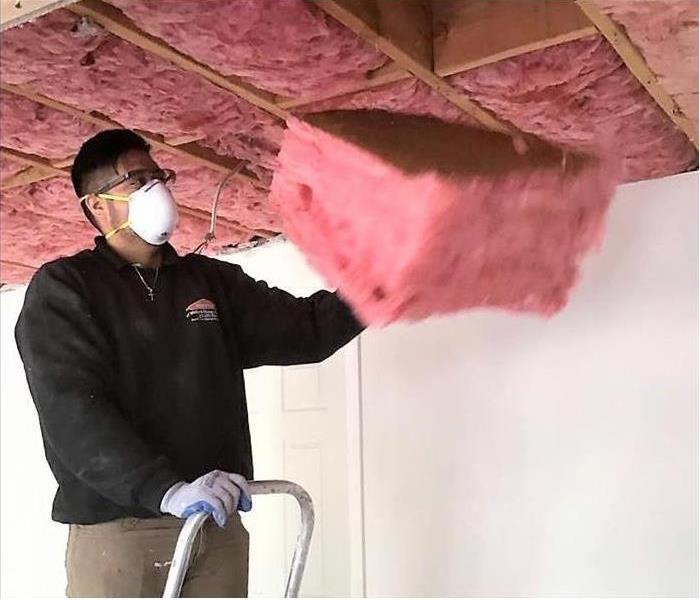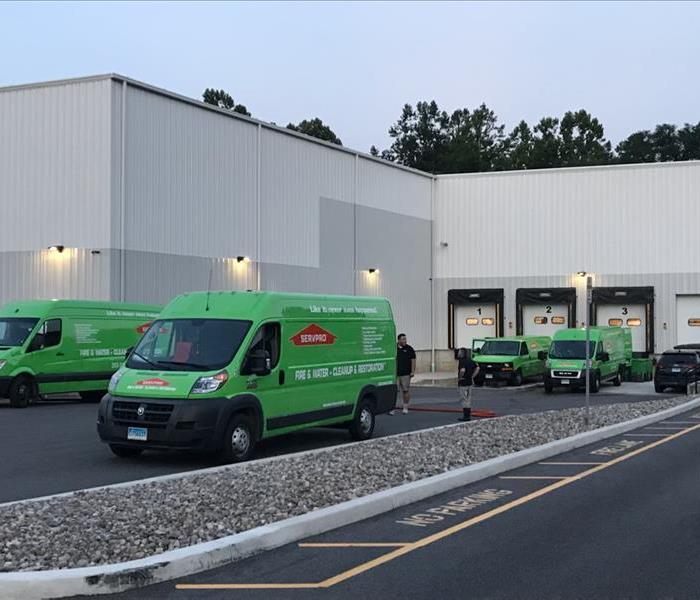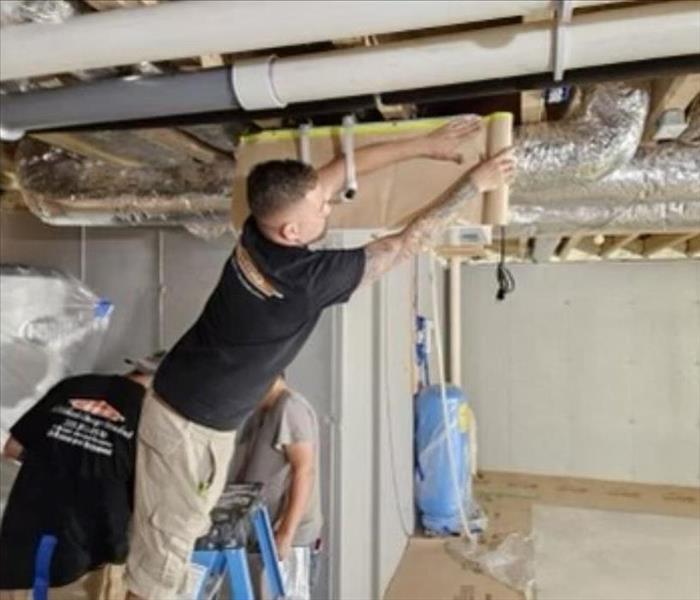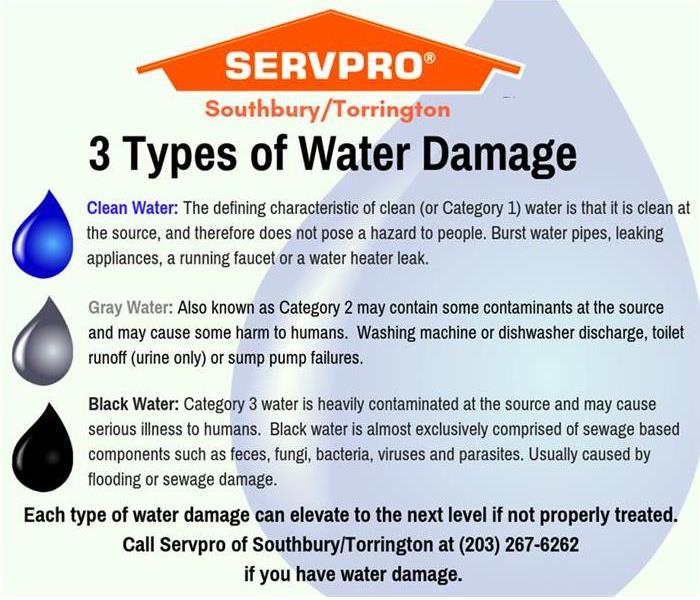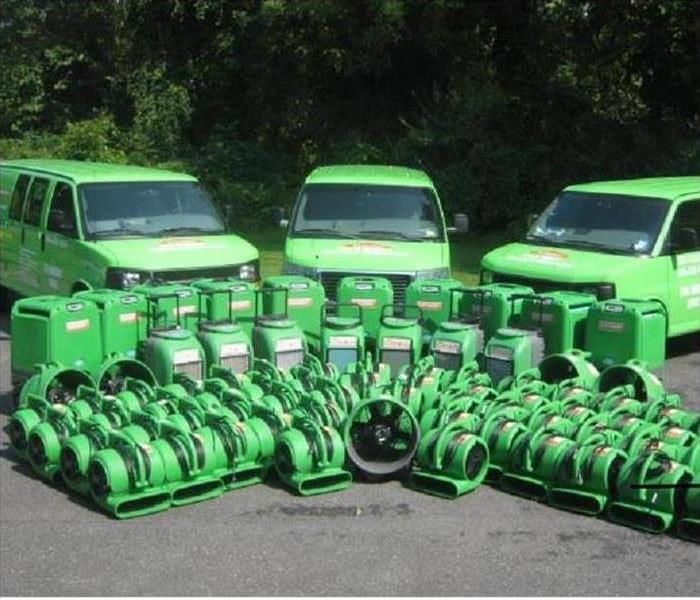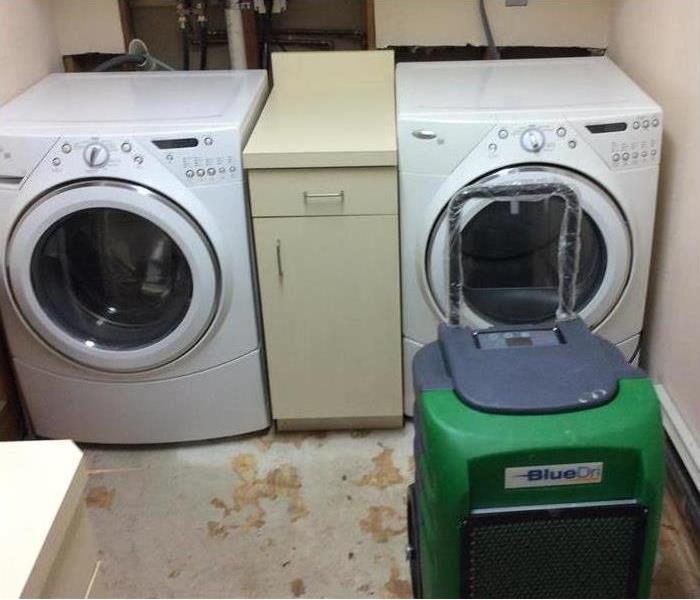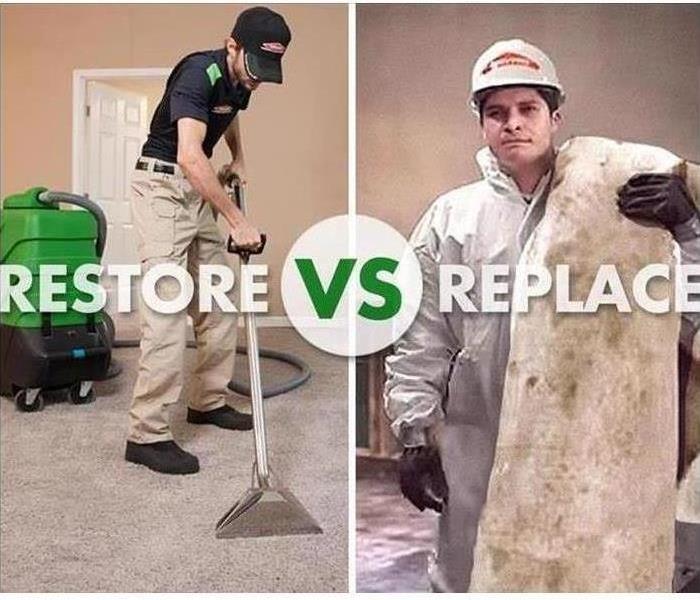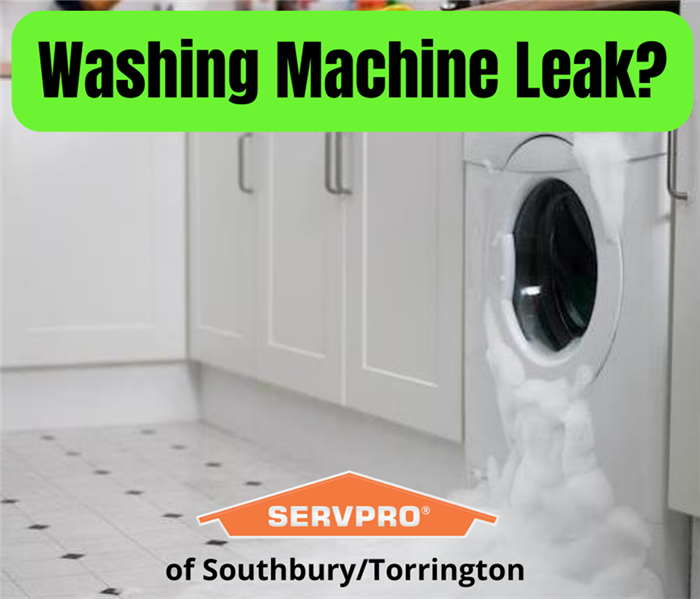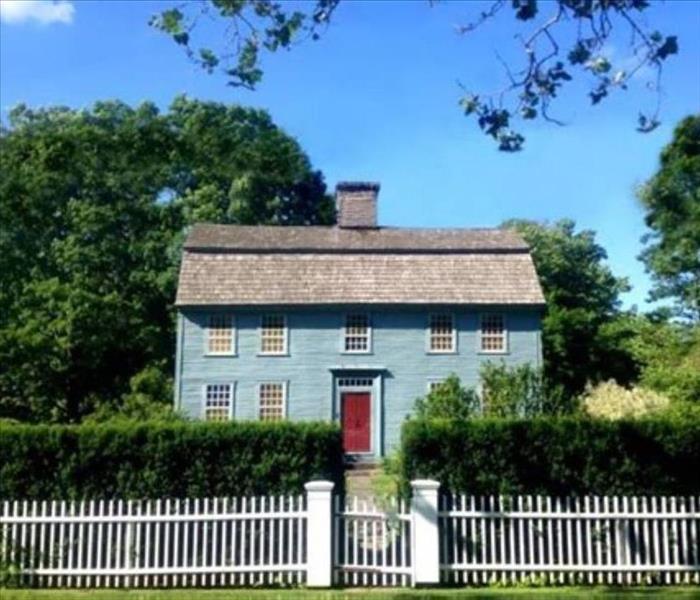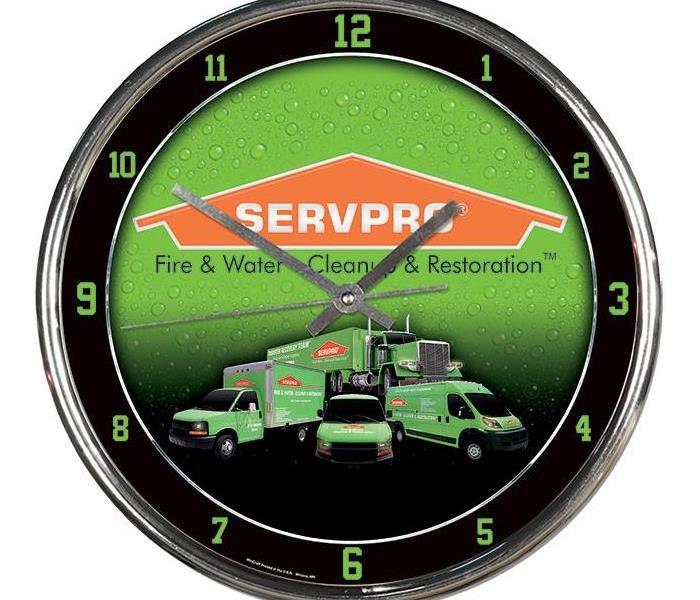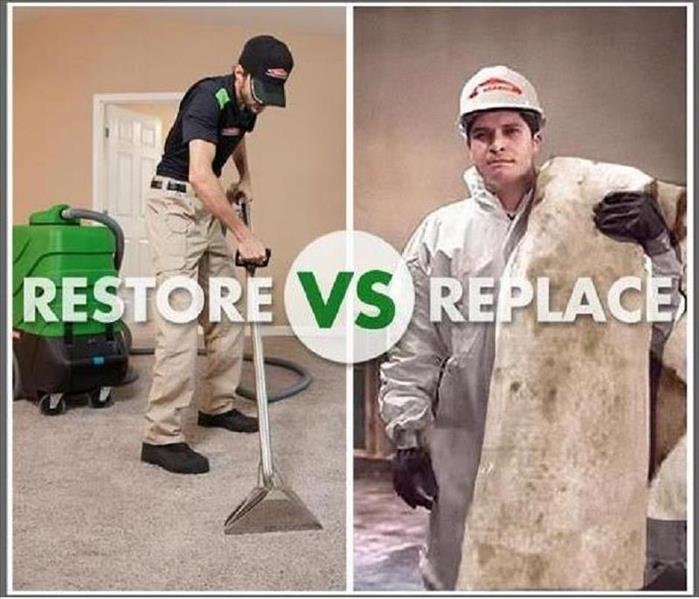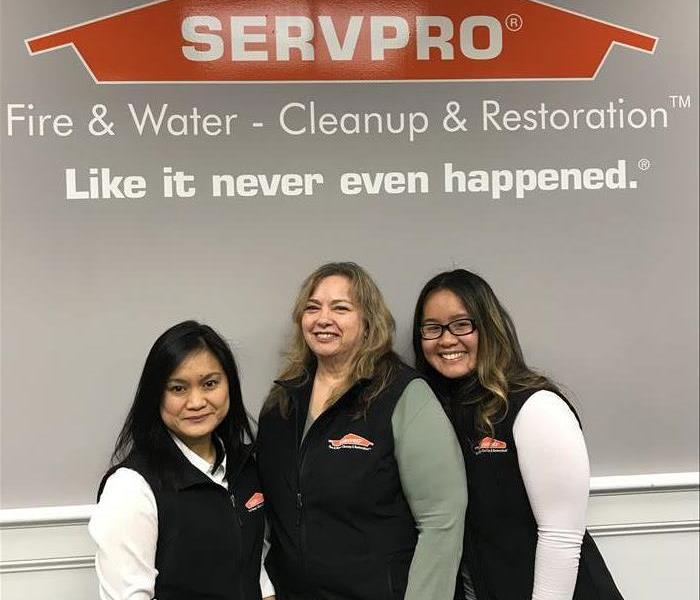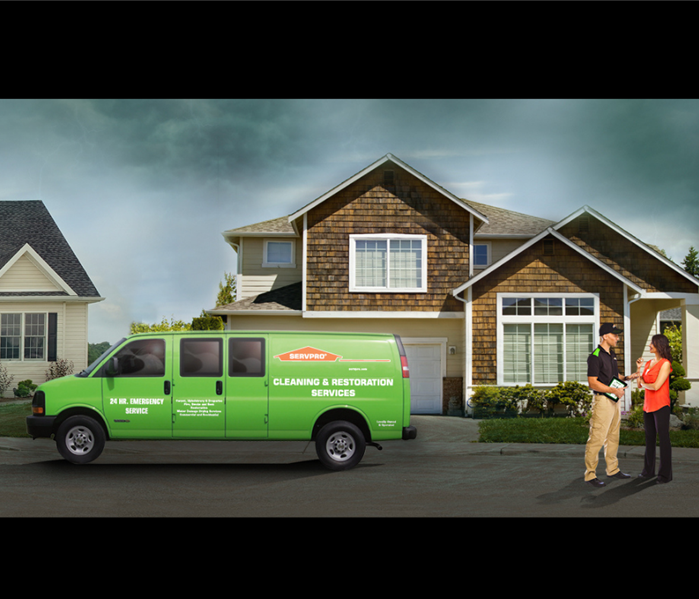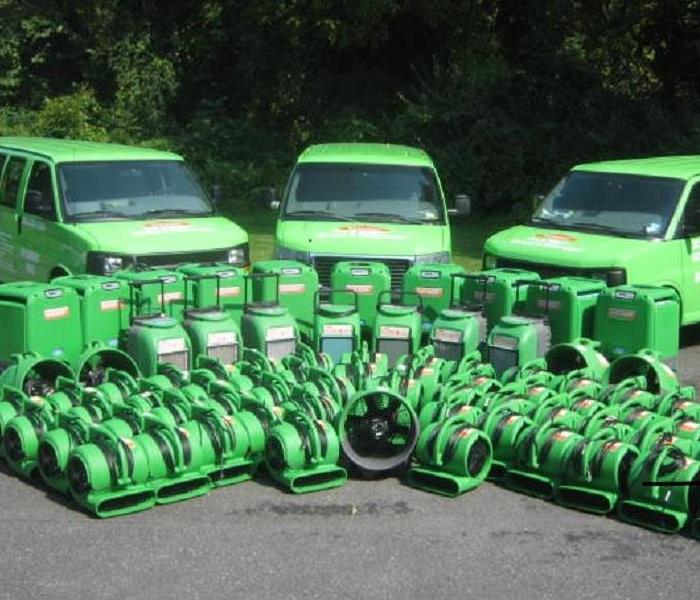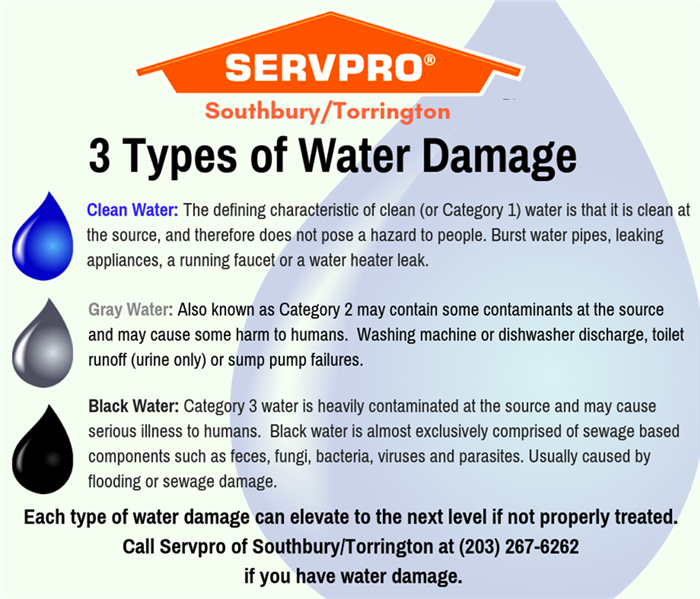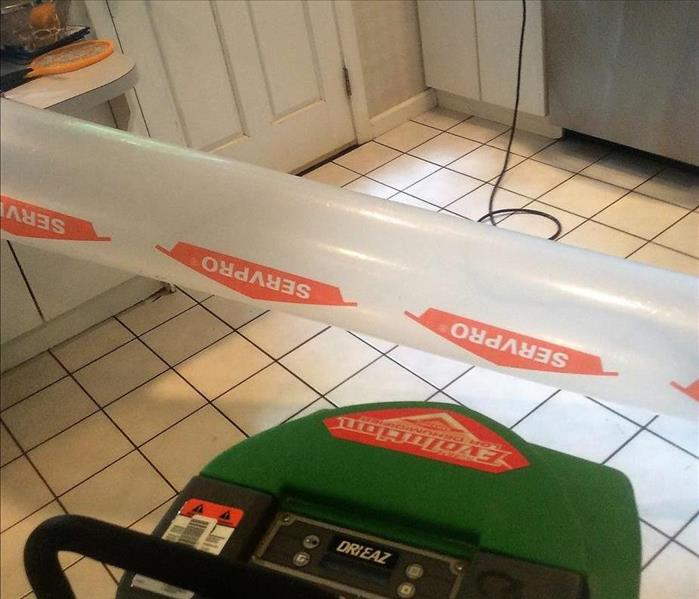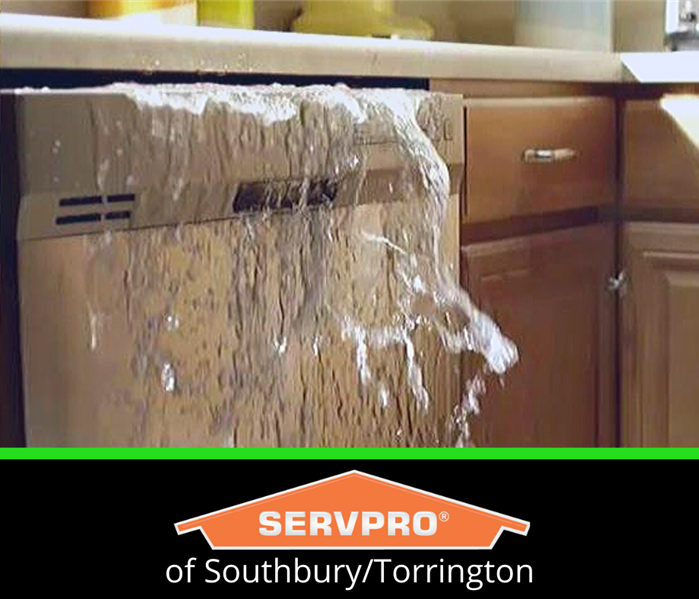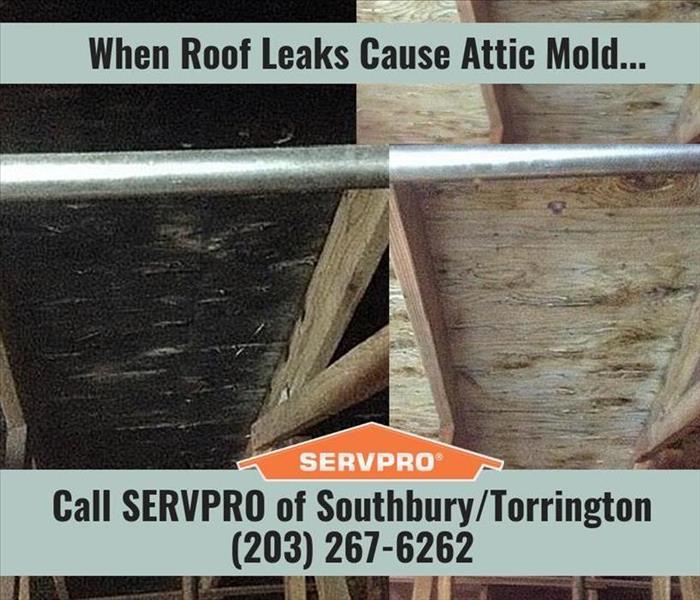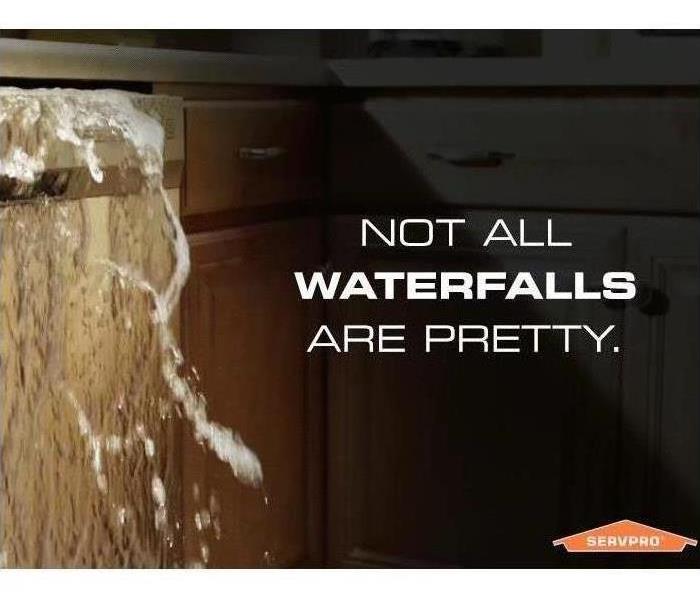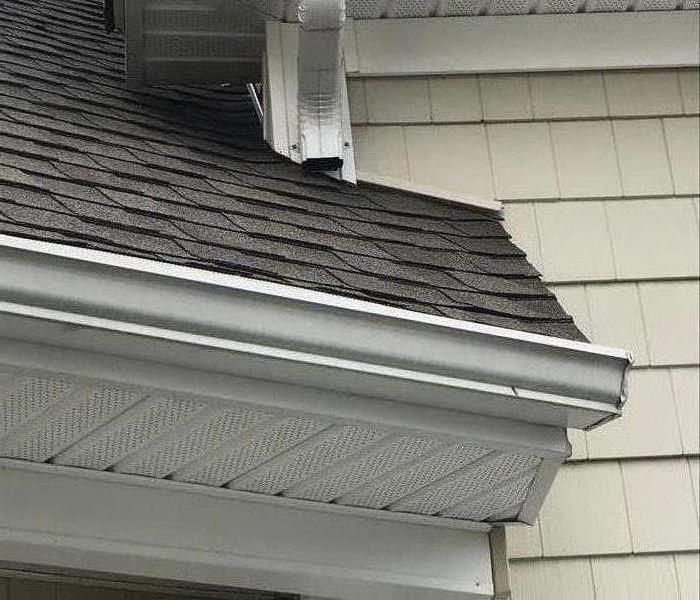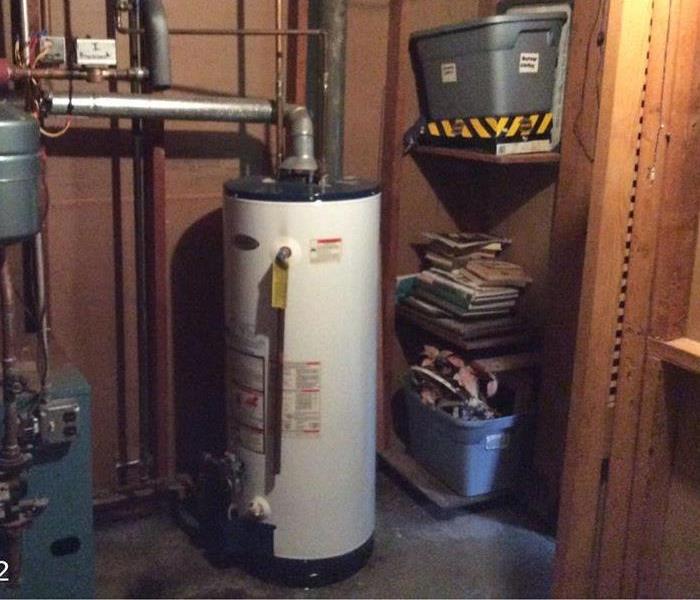Archived Water Damage Blog Posts
Restoring Peace of Mind: Dealing with Water Damage
6/17/2024 (Permalink)
Imagine coming home to discover your house transformed into a watery disaster zone, courtesy of a burst pipe. It's a scenario that strikes fear into the hearts of homeowners everywhere. However, amidst the chaos and despair, there exists a beacon of hope: SERVPRO®, the trusted name in water damage restoration.
The Calamity: A Burst Pipe
The sudden rupture of a water pipe can turn a peaceful home into a scene of chaos within minutes. Whether due to aging infrastructure, extreme temperatures, or an unforeseen accident, a burst pipe unleashes gallons of water into places where it doesn't belong. From soaking carpets and furniture to seeping into walls and ceilings, the damage can be swift and extensive.
Initial Response: Navigating the Crisis
In such moments of crisis, quick action is crucial. The first steps involve shutting off the water supply to prevent further flooding and ensuring the safety of all occupants. Once these immediate concerns are addressed, the focus shifts to damage assessment and mitigation. Here's where SERVPRO steps in.
SERVPRO: The Restoration Experts
SERVPRO is not just a cleanup crew; we are a lifeline in times of water damage emergencies. With their expertise and experience, SERVPRO teams swiftly assess the extent of the damage. Our thorough inspection identifies areas affected by water intrusion, even those not immediately visible to the untrained eye.
The Restoration Process
Once the assessment is complete, our team formulates a comprehensive restoration plan tailored to each unique situation. This plan typically includes:
Water Extraction: Using powerful pumps and vacuums, SERVPRO extracts standing water from affected areas, minimizing further damage and mold growth.
Drying and Dehumidification: Industrial-grade air movers and dehumidifiers are deployed to remove moisture from floors, walls, and air spaces. This step is crucial in preventing secondary damage and mold formation.
Cleaning and Sanitizing: Salvageable belongings and structures are meticulously cleaned and sanitized to mitigate the effects of water damage and restore them to preloss conditions.
Restoration: Finally, our skilled technicians undertake repairs and reconstruction as necessary. This may involve replacing drywall, repairing structural damage, or restoring damaged surfaces like carpets and hardwood floors.
Beyond Restoration: Restoring Peace of Mind
While SERVPRO's primary mission is physical restoration, our impact goes beyond repairing walls and floors. We restore peace of mind to homeowners by handling the complexities of insurance claims and providing clear communication throughout the process. Our dedication to customer satisfaction ensures that homeowners can focus on rebuilding their lives with minimal disruption.
Understanding Water Damage
5/2/2024 (Permalink)
Water damage can strike unexpectedly, wreaking havoc on our homes and lives. Whether it’s from a burst pipe, a leaking roof, or a natural disaster like flooding, the aftermath of water damage can be overwhelming. However, there's hope in the form of water damage restoration professionals who specialize in bringing order back to chaos.
Understanding Water Damage
Before delving into the restoration process, it's crucial to understand the different categories and classes of water damage. Water damage is categorized into three levels:
Clean Water (Category 1): This type of water damage involves water that doesn’t pose an immediate health risk. It typically comes from sources like broken pipes, overflowing sinks, or rainwater.
Grey Water (Category 2): Grey water is slightly contaminated and may cause discomfort or illness if ingested. It can come from sources like dishwashers, washing machines, or sump pump failures.
Black Water (Category 3): This is the most severe type of water damage and poses significant health risks. Black water contains harmful bacteria and pathogens, often stemming from sewage backups, floodwaters, or stagnant water.
Additionally, water damage is classified into four classes based on the extent of saturation and evaporation:
Class 1: Minimal damage with only a small area affected, typically involving materials with low porosity like concrete or hardwood.
Class 2: Significant damage with a larger area affected, including materials with moderate porosity like carpets and cushions.
Class 3: Extensive damage where water has been absorbed into walls and saturated the area, requiring specialized equipment for drying.
Class 4: Deeply entrenched water damage, often requiring specialized drying techniques for materials like hardwood floors or plaster.
The Restoration Process
Water damage restoration is a multi-step process that requires precision, expertise, and quick action to minimize further damage. Here’s an overview of the typical restoration process:
Assessment and Inspection: Restoration professionals begin by assessing the extent of the damage and identifying the category and class of water involved. This assessment helps them develop a tailored restoration plan.
Water Extraction: Using powerful pumps and vacuums, excess water is swiftly removed from the affected area. This step is crucial in preventing further damage and mold growth.
Drying and Dehumidification: Industrial-grade dehumidifiers and high-speed air movers are employed to remove moisture from the air and surfaces. This step may take several days to ensure thorough drying.
Cleaning and Sanitizing: Once the area is dry, thorough cleaning and sanitization are essential to prevent mold, bacteria, and odors from developing. Restoration professionals use specialized cleaning agents and equipment for this purpose.
Restoration and Repairs: The final step involves restoring the affected area to its pre-damaged condition. This may include repairing structural damage, replacing flooring or drywall, and restoring damaged belongings.
Importance of Professional Restoration
While DIY solutions may seem tempting, water damage restoration is best left to the professionals for several reasons:
Expertise and Experience: Restoration professionals have the knowledge, training, and experience to handle water damage of any scale safely and effectively.
Specialized Equipment: Professionals utilize advanced equipment and techniques for water extraction, drying, and restoration, ensuring thorough and efficient results.
Prevention of Secondary Damage: Prompt action by professionals helps prevent secondary damage such as mold growth, structural deterioration, and health hazards.
Insurance Assistance: Many restoration companies work directly with insurance companies to streamline the claims process, alleviating stress for homeowners during an already challenging time.
Water damage can be a devastating experience, but with the help of skilled professionals, homes can be restored to their former glory. From initial assessment to final restoration, the water damage restoration process requires precision, expertise, and a commitment to excellence. By entrusting the task to the professionals at SERVPRO of Milford-Orange-Stratford, homeowners can regain peace of mind and restore comfort to their living spaces.
We are Southbury's Leading Water Damage Restoration Team
8/28/2023 (Permalink)
Most people know that SERVPRO is the nation's leader in water damage restoration.
You've seen the commercials, our trucks out on the road and perhaps a friend has used our service. However, many of our restoration customers are surprised to learn that our franchise, SERVPRO of Southbury/Torrington, offers construction services as well.
After the fire is put out, the water is extracted, the structure dried, the odor removed, the mold remediated, and the contents cleaned, there is often still the issue of returning the physical structure back to preloss condition. When our restoration crew has completed the restoration of water and fire damage in a structure, our building services team will take over for the rebuilding phase.
Our professional and licensed contractors will meet with you to assess the damage and formulate a plan to rebuild your home or business.
Whether you need a few walls in your home sheet-rocked, a total replacement of your kitchen or a new roof, our team is trained and experienced to do the job. We work with your homeowner's insurance company estimator to ensure that the repair costs are in line with your policy's coverage.
Using our building services team for your construction needs streamlines the process for you, enabling you to get back into your home as soon as possible. If you've had a fire in your Milford home, we know that you have been through a traumatic experience.
Our goal is to leave our customers a home that is even better than before their disaster happened.
Help for Flooded Homes and Businesses
8/24/2023 (Permalink)
The reality is that despite precautions, flooding still happens and needs to be cleaned up quickly to prevent secondary damage. Quick action is the key to limiting damage if you have flooding. Here are some actions that can prevent mold from growing in your home.
- Protect your belongings – remove light furniture and upholstered items as well as other items that are susceptible (cardboard boxes, carpets and other porous items) from the affected area.
- Remove as much water as possible using a wet/dry vacuum.
- Use fans to circulate the air and speed up the drying process. A good rule of thumb is to run the fans for an additional week after the area appears dry.
- A dehumidifier can be used as well to remove excess moisture and dry out the room.
Water damage can easily be hidden underneath rugs or carpet, so be sure to give your home a thorough inspection if you suspect water damage. Although carpets can be steam cleaned, they are tough to treat and padding typically cannot be saved.
If you do have wall to wall carpeting in your basement that has gotten wet from flood water, give us a call. We are an IICRC trained mold and water mitigation company and have the tools and expertise to treat your home for damage.
Floodwater vs Sewage Water
9/21/2022 (Permalink)
Our approach to treating water damage in Connecticut homes depends on which category it falls into.
CAT 1 or Clean Water
Clean water is just that- water that has come from a source that is not contaminated. Examples of this would be a pipe bursting or a refrigerator leak. Also, if you have a leak that allows rainwater in through your roof, it is considered clean. Although clean water can cause significant damage, it is not considered hazardous to human health as there are no microbes in the water. The biggest hazard clean water presents is if the area that has been damaged is not properly cleaned and dried. This can result in mold and fungus growth.
CAT 2 or Gray Water
Gray water is water that is slightly contaminated, either because of the nature of the source or because of neglect. For example, clean water can become “gray” water if it is left untreated for an extended period time. When a toilet or washing machine overflows, the resulting water would be considered gray because of its source. Toilet overflows containing urine only are considered gray.
CAT 3 or Black Water
CAT 3 water is highly dangerous to human health. Black water can include toxic materials such as bacterial diseases, chemicals, pesticides, microbes and more. Sewage based components such as bacteria, fungi, feces, viruses and parasites. Black 3 water situations are usually caused by sewage backups or overflows and flooding.
Since the human eye cannot see bacteria, it is not always obvious whether the water in your home is a CAT 2 or CAT 3. If you experience a flood from a heavy rain, the water may look “clean,” but if there is any ground water that has backed up into your home as a result, there may be invisible microbes lurking in the water.
Any water damage that is not treated correctly will eventually elevate to the next category. Even a simple pipe burst can turn into a biohazard and mold issue if not treated.
If you have any water damage in your home, call Southbury/Torrington at (203) 743-5362 for service that you can count on.
The Green Machines and What They Do
7/14/2022 (Permalink)
Your Southbury area business has had water damage. Perhaps a pipe has broken, a toilet overflowed or your coffee maker line sprung a leak.
You’ve called SERVPRO of Southbury/Torrington and have been assured that the crew is on their way to clean up the mess. After our property manager has inspected your property, work will begin based on their assessment. The crew will start to unload the trucks and begin work. While the bright green equipment is getting set up throughout your facility, you will likely wonder what all of it does.
When water damage occurs, we typically use the following equipment.
Air Mover and/or Axial Fans: Professional grade air movers and axial fans produce more air movement than a standard household fan. The higher volume of air being moved increases the rate of evaporation, helping to dry the structure as quickly as possible.
Dehumidifiers: A dehumidifier removes water vapor from the air by condensing it out against refrigerated fins. The water is stored and then periodically purged from the machine by use of plastic tubing. The tubing will generally be run so that it dumps water down a drain, such as a bath tub or sink, or sometimes out a window or door. Professional dehumidifiers pull much more vapor from the air than a household dehumidifier. In this way they are generally more efficient.
Air Scrubbers: An air scrubber might be used if your loss is a result of water classified as grey or black, which means that it came from a contaminated source or through building materials. These machines remove airborne particulates by trapping them in HEPA filters. Air Scrubbers are also used in cases where a customer has a health condition that requires the air quality be monitored.
Specialty Drying Equipment: There are a variety of different tools available to our technicians for use in specialty circumstances. For instance, a floor drying mat system allows the technician to create a vacuum system for removing moisture from hardwood floors, in order to try to dry them in place. This helps the floor dry faster, and generally gives us a better chance of saving the hardwood flooring.
If you have any questions about the equipment being used during the restoration of your commercial property, our crew chiefs and technicians are always available to explain the process and what the function of each of those machines in your building is.
We understand that our customers are not experts in water damage restoration. When you have water damage, we are here to help restore your property quickly and efficiently.
When Appliances Break
5/31/2022 (Permalink)
Floods can happen without warning - you turn on your washing machine that has been working fine and the next moment, water is everywhere. Our team has been to thousands of water damage restoration jobs in the Southbury area and have identified the main causes of flooding from household appliances in our area.
HOT WATER HEATER
Did you know that about 75% of tank water heaters fail by the time they’re 12 years old, typically due to leaks or burst tanks? The average cost of damage from a water heater failure is $4,000. Proactive tasks include: inspecting your tank regularly for leaks.An inspection should include flushing the tank, inspecting the anode rod, examining shut-off values and checking water heater piping.
WASHING MACHINE
More than half of all water damage are due to broken washing machine hoses, with damages average more than $6,000. So, an easy way to reduce your risk of a flood is to inspect your hoses once a month and look for signs of impending leaks, such as blisters, bulges, cracks, discoloration or kinks.
DISHWASHER
Dishwashers usually fail when they are 10-12 years old, with flooding damage from a dishwater leak averaging $5,000. Keep an eye on connections and small parts, which are often the cause. Tighten the drain line where it connects to under-sink plumbing. Choosing a steel-braided hose over a rubber one is always recommended as well.
REFRIGERATOR
We all love our ice makers (remember having to fill the old cube trays? However, ice makers are the primary cause for water leaks in a refrigerator. Replace copper water lines with braided steel alternatives. Check the water supply line behind the fridge yearly. Tighten the compression nut to prevent a slow drip from causing hidden damage.
AIR CONDITIONER
When an HVAC air conditioners is installed in the attic, it can cause the most damage because water can leak throughout the entire home. Installing a secondary drain line and drain pan overflow switch can help. Also, have your A/C maintained regularly, which includes changing the filter and checking the refrigerant level.
Can Your Wet Carpet Be Saved?
3/28/2022 (Permalink)
What’s to be done about carpeting when you’ve had a flood in your home?
Water damage restoration is not a “one size fits all” solution and while it’s true that carpeting is unsalvageable in many situations, that’s not always the case.
How does our team overcome wet carpeting?
Our approach to carpet restoration and water extraction varies depending on the fiber count and thickness of the carpet itself, as short pile carpeting (glue down) absorbs less water than plusher options. The restoration of carpets requires a combination of several water removal tools exclusively designed for this porous flooring. Some of the devices and machines our team uses in this process include:
- Carpet Wands – The addition of specialty attachments like carpet wands to the wet vacuums and pumps already in use is a versatile implement to the extraction of water. These attachments are a focused vacuum head used on the surface of carpeting to pull the majority of moisture from the fibers and backing material.
- Weighted Extractors – When it is possible to restore the carpet, the padding, and the underlying material, it is critical to reduce their oversaturation quickly. The best approach for this is a weighted extraction option that utilizes a technician's weight on a stationary or ride-on unit. The heft of the machine and the operator press the carpet and padding against the subflooring to force moisture to the surface for removal.
- Floating – Once most of the moisture has been removed by weighted extraction, floating the carpet by placing a centrifugal air mover between the carpet and padding layers dry both materials simultaneously.
It's not always obvious which carpeting can be saved. For a professional assessment of your water damage situation, give us a call!
When the Washing Machine Leaks...
3/8/2022 (Permalink)
Floods can happen without warning - you turn on your washing machine that has been working fine and the next moment, water is everywhere. Our team has been to thousands of water damage restoration jobs in the Southbury area and have identified the main causes of flooding from household appliances in our area.
HOT WATER HEATER
Did you know that about 75% of tank water heaters fail by the time they’re 12 years old, typically due to leaks or burst tanks? The average cost of damage from a water heater failure is $4,000. Proactive tasks include: inspecting your tank regularly for leaks.An inspection should include flushing the tank, inspecting the anode rod, examining shut-off values and checking water heater piping.
WASHING MACHINE
More than half of all water damage are due to broken washing machine hoses, with damages average more than $6,000. So, an easy way to reduce your risk of a flood is to inspect your hoses once a month and look for signs of impending leaks, such as blisters, bulges, cracks, discoloration or kinks.
DISHWASHER
Dishwashers usually fail when they are 10-12 years old, with flooding damage from a dishwater leak averaging $5,000. Keep an eye on connections and small parts, which are often the cause. Tighten the drain line where it connects to under-sink plumbing. Choosing a steel-braided hose over a rubber one is always recommended as well.
REFRIGERATOR
We all love our ice makers (remember having to fill the old cube trays? However, ice makers are the primary cause for water leaks in a refrigerator. Replace copper water lines with braided steel alternatives. Check the water supply line behind the fridge yearly. Tighten the compression nut to prevent a slow drip from causing hidden damage.
AIR CONDITIONER
When an HVAC air conditioners is installed in the attic, it can cause the most damage because water can leak throughout the entire home. Installing a secondary drain line and drain pan overflow switch can help. Also, have your A/C maintained regularly, which includes changing the filter and checking the refrigerant level.
Special Care for Older Homes
2/7/2022 (Permalink)
The Litchfield County area is known for its beautiful old houses in a picturesque setting. Hundreds of years old, these homes are reminders of how things used to be. We’ve seen homes in which the crawlspaces reveal rocks stacked on top of each other for the foundation. That these structures still stand is a testament to the craftsmanship of our ancestors.
As impressive as old houses are, however, it is inevitable that they might be plagued by structural problems. Foundations crack and shift, creating a risk of water damage. Old electrical wires that often do not meet code can fray as well as overload the system, causing an electrical fire. The plumbing systems that were added long after these homes were built are often not installed to today’s standards. Septic systems deteriorate and break with age. There are a host of problems that cause water damage to older homes.
If you have an older home in Connecticut, be vigilant about the warning signs of water damage.
Water stains. Water stains are the most common and obvious indication that you have a leak.You may see them on the ceilings or walls. Have all water stains inspected to see what the source is.
Deteriorating wood. In particular, keep your eye on door and window frames as well as baseboards and molding which are the first areas to show water damage because of a leaking window or door.
Buckling floors. If there is an appliance leak that goes unnoticed, a pipe leak under a sink or a gap around your shower door, you may end up with floors that absorb the water. Wood flooring absorbs the water, which makes it swell and buckle. Vinyl will curl up at the edges, which gives you a clue that there is a problem.
Pay attention to suspicious smells. If you notice a moldy or mildew smell, find the source even if there is nothing visible. Water damage can cause mold to grow behind walls and can cause serious damage if not mitigated.
Do you have water damage in your older home? Call Us Today (203) 267-6262.
Clean Your Gutters to Avoid Water Damage this Fall.
9/20/2021 (Permalink)
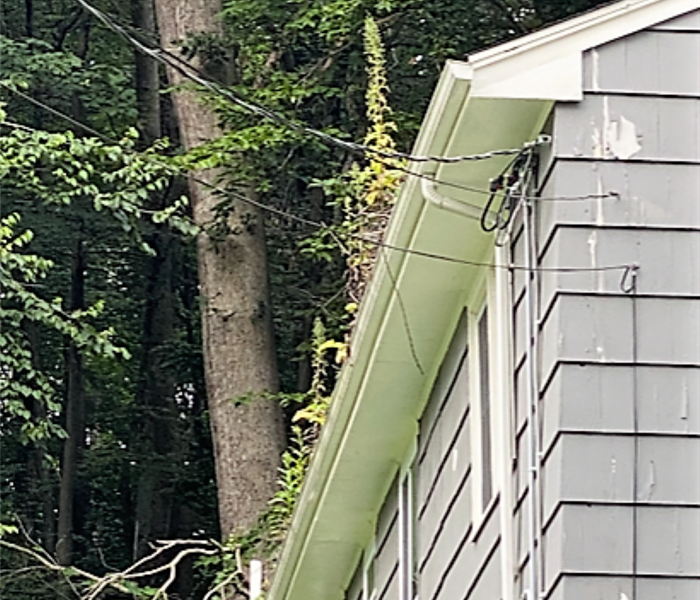 If there are plants growing out of your gutter, they cannot work properly!
If there are plants growing out of your gutter, they cannot work properly!
The start of the school year has begun, the weather has been cool and the first day of fall is next week.
With all of the pumpkiny, cinnamon-spicey, sweatery ads popping up in my Facebook feed, it comes at no surprise! And I have to admit that as much as I am sorry to see summer end, fall is my favorite season and I am looking forward to the crisp air and coziness that it brings. We are so lucky to live in New England and be surrounded by the fall colors that the changing of the leaves brings. Of course, those leaves fall and often land in our gutters, which can cause water damage to your home.
I’m sure that it goes without saying for most of you, however, I’m going to go ahead and remind you to clean out your gutters this fall.
I usually find myself doing this task twice- once at the beginning of the season to get all of the wet, decaying leaves and twigs that have accumulated all year out. Then, I go out a second time in November, after all of the leaves have fallen but before the snow falls, to do a clearing of all of the new leaves. I do want to caution our readers that cleaning gutters should be done with care. If it cannot be done safely, please reach out to one of the many wonderful specialists in our area to do it for you.
A common cause of roof and water damage in residential properties is malfunctioning gutters.
When your gutters are clogged, the water collects and spills out of the top in both directions. When it falls away from your house, it pools and causes problems at your foundation level, causing damage to your foundation and often flooding your basement. When it flows out onto your roof, it can create a leaking problem in your attic. Roof leaks often go unnoticed because most of us don’t make frequent visits into our attic spaces. But, eventually, the water will make its way into the insulation, walls and ceilings of your home. Roof leaks are also a common reason why attic mold grows.
Cleaning out your gutters lowers your risk of basement flooding and roof leaks.
However, if you do find yourself with a flood due to clogged gutters, don’t worry - we won’t judge! We understand that despite a homeowner’s best intentions, life gets busy and accidents happen! Give our office a call and schedule an appointment with our team to restore your home “Like it never even happened.”
Video on how to clean out your gutters
Contact us if you have water or mold damage.
When it Comes to Water Damage, Timing is Everything
7/24/2021 (Permalink)
If your Woodbury home has experienced water damage, whether from a pipe burst, an appliance line leak or a flooded basement, calling a restoration company immediately will reduce the damage to your home and possessions. The sayings "time is of the essence" and "there's no time to waste" are applicable here. The longer that your home is left untreated, the greater the effects of the water damage will be.
What might appear as a water stain in the morning could progress to the ceiling having fallen on your couch by noon. Once wet, sheetrock can quickly deteriorate and fall to pieces. As time passes after a water damage event, the flooding can cause your porous furnishings such as carpeting, mattresses and furniture to become water logged, rendering them unsalvageable. Home insulation and carpet padding also retain moisture. Electronics are susceptible to internal degradation from the moisture in the air. When treated quickly, wood and laminate flooring can often be saved using our floor mat system however if left to penetrate and go beneath the wood to the subfloor, this option is unlikely.
Secondary water damage issues can also arise if restoration is delayed. What may have entered your home as clean water, such as an ice dam melting through your ceiling or water from a faucet leaking, may become contaminated and change to gray or black water, which can be a health concern and require a higher degree of handling. The growth of mold spores is also a concern when a home has had flooding that goes untreated.
Upon arrival to your home after we receive your call, one our estimators will assess the damage. If you have not yet determined the cause of the water damage, their first course of action will be to do so. Our technicians use a variety of tools such as moisture readers and sensors, probes and infrared technology in their evaluation. This, coupled with decades of experience and the highest level of industry training, gives them an accurate picture of the situation.
Typically, our first course of treatment is to remove any standing water from your home using water extractors, submersible pumps, dehumidifiers and air movers. If necessary, we will order dumpsters to be brought to your home for the disposal of unsalvageable personal items and structural materials such as flooring, carpeting and wallboard. Our crew may also move household belongings from your home to our storage facility while your home is being cleaned. They may also restore some items such as furniture, area rugs, and photos off site. Throughout the process, our office staff will communicate with your insurance company to address any concerns and gain approval for planned restoration work.
After we have removed the excess water from your home, we begin sanitizing it. We use both wet and dry cleaning methods to remove dirt and pollution from the carpets, walls, furniture, baseboards, appliances and pieces of furniture that were affected by the water. Industrial air scrubbers, which clean the air by passing it through special filters, remove any contaminants from the air of the home. Our crew uses antibacterial and antimicrobial treatments to sanitize and disinfect any contaminated items and deodorization to eliminate any odors.
Once your home is dry, clean and restored, we are able to bring your household items back, have the dumpsters removed and move our equipment out. Although each water damage restoration job we encounter is unique, our essential approach is consistent. At SERVPRO of Southbury/Torrington, our goal is to arrive at your home and begin the water damage process quickly after receiving your call, restore it professionally and thoroughly and help you get back to normalcy. If you experience water damage in the Southbury area, call our office at (203) 267-6262. We are available 24 hours a day and have staff ready to respond to your call.
Should Your Water Damaged Carpet be Restored or Replaced?
6/1/2021 (Permalink)
When there is a flood, a building's carpet is usually affected. Whether a traditional cut pile or a commercial glue down, wet carpet always needs to be addressed. Our treatment of damaged carpet is not a one-size fits all application, but rather it varies depending on the category of water loss and current condition of carpet
There are three categories that water flooding falls into.
Category 1 is clean water that may be found when a bathtub overflows or ice maker line leaks. If the restoration process begins within hours of occurring the likelihood of salvaging the carpet is extremely high.
Category 2, also referred to asgray water, is water that has picked up some forms of contamination, such as water from the dishwasher or a washing machine flood. The soap, food particles and soil that are found in the water create a CAT 2 water loss. Salvaging carpets under this condition is also possible however the emergency service of drying must begin quickly.
Category 3 water damage is defined by water that is contaminated and potentially hazardous. Think raw sewage or water damage that started as another category due to prolonged interaction with bacteria and other pathogens on the building materials that populate due to the increased moisture content. Toilet overflows, sewage backups and flooding from ground water are examples of a CAT 3. Carpeting hit by CAT 3 water is not salvageable.
In the end, safety is our number one priority when determining whether your carpet will be restored or replaced.
The Water Damage Process Explained
4/5/2021 (Permalink)
Quick action is crucial when you are dealing with water damage. The severity of the damage to your home can increase within just a few hours. This is the case no matter what has caused your water damage- whether it be from a broken refrigerator supply line, a leaking roof or a water heater burst.
When they pick up your call, Theny and Alexis, our Torrington office staff, understand that you may be feeling overwhelmed, stressed, and a bit vulnerable. Our staff has experience of taking hundreds of calls like yours each year and can calmly guide you through the process.
Upon answering your call, we will gather the necessary information in order to determine what equipment and resources will be needed as well as the size of the crew to send.
Some of the questions we might ask are:
- Your name and phone number as well as email address
- If you are a renter or property manager, the homeowner's contact information
- Your home insurance policy information
- The street address of the water-damaged home or business as well as the billing address
- When the water damage occurred and what caused it
- Whether there is electricity and heat available in the home
The following step will be for the office to schedule an appointment for one of our estimators to come to your home along with a crew to inspect the damages and formulate a restoration plan. The information that they have gotten from your call will help them determine how many technicians to send and what type of equipment is needed. Once we have inspected the damage, our crew will begin work.
We know that most of our clients have not experienced water damage before and may be unfamiliar with the terminology used and why certain actions need to be taken. Please know that if at any point you feel this way, our production managers and office staff are available to answer your questions.
The team at SERVPRO of Southbury/Torrington are your Connecticut water restoration specialists. If you have a flood or leak, call us at (203) 267-6262.
How to Find the Right Water Damage Restoration Company When Your Home is Flooded
3/23/2021 (Permalink)
Since most people haven’t researched and chosen a water restoration company prior to having a disaster, the decision is often made while in the midst of an emergency situation.
Most of our emergency water damage customers learn about our company in a few ways.
- A Personal Recommendation. As stressful as it can be to have your home flooded, having a friend or family member recommend a company that they’ve used can make your situation a bit easier. At SERVPRO of Southbury/Torrington we get a lot of our jobs from personal recommendations. We work hard to make each and every customer satisfied and, in turn, our customers often recommend us to others.
- An Insurance Agent. The first person who you will most likely talk to when you have flooding is your homeowner’s insurance agent. They are the perfect person to ask for a recommendation - they have more experience with water damage restoration companies than anyone else you’ll find! They know which companies are reliable and professional and they hear all of the complaints as well. Asking your agent for a referral is a smart move if you want to have a positive experience.
- An Internet Search. In today’s world, we have access to much more information about a company than we did back in the days of the yellow book. Most restoration companies have a website, Facebook page and online reviews that you can use to make your decision.
Water damage in your home is stressful but choosing a restoration company doesn’t have to be.
SERVPRO of Southbury/Torrington is highly recommended in the Hartford County area because of our highly trained professionals who go above and beyond to help our customers.
Freezing Pipes Burst in Southbury Homes
2/16/2021 (Permalink)
With the thermometer dipping last week, pipes in Litchfield County homes began freezing and, in may cases, burst.
Although pipes can freeze anywhere in your home, there are some areas that are more susceptible than others.
1. Your Crawlspace - Many older homes in CT have a crawlspace rather than a full basement. These are typically not insulated and the pipes are exposed to the environment. Lining the sides of the space with foam board and the ground with plastic can help. You may also consider installing a heat cable that runs along the pipes and is turned on when the temps drop.
2. Under the Kitchen Sink - In particular, sinks that are on an exterior wall tend to experience frozen pipes. An easy solution to this is leaving your cabinet doors open to allow the warm air in the home to circulate.
3. Bonus Rooms Above the Garage - Most bonus rooms are built above an unheated garage. They are exposed to the cold air (especially along the exterior walls). Keeping the temperature in your garage above freezing with the use of space heaters on frigid days can help.
Frozen pipes can happen to anyone. We have responded to water damage from burst pipes in houses built in the 1700's as well as homes that are new construction. We've seen it all and have the experience to restore your home quickly and thoroughly
Your Home has Water Damage and You've Called SERVPRO. What's Next?
10/5/2020 (Permalink)
Your Southbury area business has had water damage. Perhaps a pipe has broken, a toilet overflowed or your coffee maker line sprung a leak.
You’ve called SERVPRO of Southbury/Torrington and have been assured that the crew is on their way to clean up the mess. After our property manager has inspected your property, work will begin based on their assessment. The crew will start to unload the trucks and begin work. While the bright green equipment is getting set up throughout your facility, you will likely wonder what all of it does.
When water damage occurs, we typically use the following equipment.
Air Mover and/or Axial Fans: Professional grade air movers and axial fans produce more air movement than a standard household fan. The higher volume of air being moved increases the rate of evaporation, helping to dry the structure as quickly as possible.
Dehumidifiers: A dehumidifier removes water vapor from the air by condensing it out against refrigerated fins. The water is stored and then periodically purged from the machine by use of plastic tubing. The tubing will generally be run so that it dumps water down a drain, such as a bath tub or sink, or sometimes out a window or door. Professional dehumidifiers pull much more vapor from the air than a household dehumidifier. In this way they are generally more efficient.
Air Scrubbers: An air scrubber might be used if your loss is a result of water classified as grey or black, which means that it came from a contaminated source or through building materials. These machines remove airborne particulates by trapping them in HEPA filters. Air Scrubbers are also used in cases where a customer has a health condition that requires the air quality be monitored.
Specialty Drying Equipment: There are a variety of different tools available to our technicians for use in specialty circumstances. For instance, a floor drying mat system allows the technician to create a vacuum system for removing moisture from hardwood floors, in order to try to dry them in place. This helps the floor dry faster, and generally gives us a better chance of saving the hardwood flooring.
If you have any questions about the equipment being used during the restoration of your commercial property, our crew chiefs and technicians are always available to explain the process and what the function of each of those machines in your building is.
We understand that our customers are not experts in water damage restoration. When you have water damage, we are here to help restore your property quickly and efficiently.
CAT 1. CAT 2. CAT 3. What's the Difference?
7/27/2020 (Permalink)
Our approach to treating water damage in Connecticut homes depends on which category it falls into.
CAT 1 or Clean Water
Clean water is just that- water that has come from a source that is not contaminated. Examples of this would be a pipe bursting or a refrigerator leak. Also, if you have a leak that allows rainwater in through your roof, it is considered clean. Although clean water can cause significant damage, it is not considered hazardous to human health as there are no microbes in the water. The biggest hazard clean water presents is if the area that has been damaged is not properly cleaned and dried. This can result in mold and fungus growth.
CAT 2 or Gray Water
Gray water is water that is slightly contaminated, either because of the nature of the source or because of neglect. For example, clean water can become “gray” water if it is left untreated for an extended period time. When a toilet or washing machine overflows, the resulting water would be considered gray because of its source. Toilet overflows containing urine only are considered gray.
CAT 3 or Black Water
CAT 3 water is highly dangerous to human health. Black water can include toxic materials such as bacterial diseases, chemicals, pesticides, microbes and more. Sewage based components such as bacteria, fungi, feces, viruses and parasites. Black 3 water situations are usually caused by sewage backups or overflows and flooding.
Since the human eye cannot see bacteria, it is not always obvious whether the water in your home is a CAT 2 or CAT 3. If you experience a flood from a heavy rain, the water may look “clean,” but if there is any ground water that has backed up into your home as a result, there may be invisible microbes lurking in the water.
Any water damage that is not treated correctly will eventually elevate to the next category. Even a simple pipe burst can turn into a biohazard and mold issue if not treated.
If you have any water damage in your home, call Southbury/Torrington at (203) 743-5362 for service that you can count on.
The Appliances That Cause Water Damage and How You Can Prevent It.
6/8/2020 (Permalink)
Floods can happen without warning - you turn on your washing machine that has been working fine and the next moment, water is everywhere. Our team has been to thousands of water damage restoration jobs in the Southbury area and have identified the main causes of flooding from household appliances in our area.
HOT WATER HEATER
Did you know that about 75% of tank water heaters fail by the time they’re 12 years old, typically due to leaks or burst tanks? The average cost of damage from a water heater failure is $4,000. Proactive tasks include: inspecting your tank regularly for leaks.An inspection should include flushing the tank, inspecting the anode rod, examining shut-off values and checking water heater piping.
WASHING MACHINE
More than half of all water damage are due to broken washing machine hoses, with damages average more than $6,000. So, an easy way to reduce your risk of a flood is to inspect your hoses once a month and look for signs of impending leaks, such as blisters, bulges, cracks, discoloration or kinks.
DISHWASHER
Dishwashers usually fail when they are 10-12 years old, with flooding damage from a dishwater leak averaging $5,000. Keep an eye on connections and small parts, which are often the cause. Tighten the drain line where it connects to under-sink plumbing. Choosing a steel-braided hose over a rubber one is always recommended as well.
REFRIGERATOR
We all love our ice makers (remember having to fill the old cube trays? However, ice makers are the primary cause for water leaks in a refrigerator. Replace copper water lines with braided steel alternatives. Check the water supply line behind the fridge yearly. Tighten the compression nut to prevent a slow drip from causing hidden damage.
AIR CONDITIONER
When an HVAC air conditioners is installed in the attic, it can cause the most damage because water can leak throughout the entire home. Installing a secondary drain line and drain pan overflow switch can help. Also, have your A/C maintained regularly, which includes changing the filter and checking the refrigerant level.
Appliance Leaks Cause Water Damage to Southbury Homes
4/7/2020 (Permalink)
With everyone spending more time within their homes during the pandemic, we are experiencing an increase in calls from homeowners with water damage with an appliance leak. It doesn’t take long for the water from an appliance leak to flood a house, leak through the floor and cause widespread damage. Appliance leaks cause damage to the wood flooring, carpets and the walls and ceiling of homes. The good news is that most insurance companies will cover water damage that is a result of a sudden malfunction of an appliance.
Nobody plans on an appliance leak in their home but they happen more often that you would imagine. Your immediate response when you discover an appliance leak at your home will be to stop the flow of water. Turning the water off at the main shut off valve will stop any further flooding.
After the water has been shut off, call our office at (203) (203) 267-6262. We are open 24-7 and the sooner the water damage restoration process begins, the easier the and quicker the work will be. Our team is practicing safety precautions such as social distancing, the use of personal protective equipment such as masks and gloves and sanitizing surfaces to protect them and you from any Covid-19 exposure.
Despite COVID-19, Water Damage is Still Hitting Homes and Businesses in Southbury
4/1/2020 (Permalink)
The Covid-19 pandemic has caused most of our lives to halt to a stop. Despite this, home and business owners still face many of the same challenges that existed prior to this outbreak. Dishwashers malfunction, roofs leak and basements flood just like before.
We are all concerned about spreading the coronavirus and some of our friends and customers have expressed concern over having people in their homes and businesses. Yet, water damage must be addressed quickly. Please be assured that our crew is practicing the highest level of safety as they work, for their own protection as well as yours. Some of the practices our franchise is adhering to strictly are:
- Personal Protection Equipment: Our crew is wearing gloves and masks on every job
- Social Distancing: We are following social distancing guidelines and maintaining a safe distance from each other as well as those who must remain in the building as we work
- Disinfecting: We are wiping down surfaces that we touch - such as doorknobs and light switches - with SERVPROxide, a hospital grade disinfectant. When deemed necessary, we are also applying the same disinfectant with a fogger in order to further sanitize.
Why can't you just wait for a few weeks until things go back to normal?
Unfortunately, the more time that goes by with untreated damage, the worse the situation gets.
The First 24 Hours:
- Drywall, which is found on the walls and ceilings of most Connecticut homes, gets saturated and begins to disintegrate. Many people discover their water leak only after the ceiling is already on the floor. That's how quickly this can happen.
- You will notice a musty smell and normal household odors grow stronger.
- Any uncoated metal surfaces, which are vulnerable to moisture in the air, will begin to tarnish.
- Your furniture may begin to show signs of damage. In particular, laminated furniture and flooring will begin to swell and crack due to the moisture.
- Free-floating laminated flooring may also begin to pop out of place due to swelling.
48 Hours to 1 Week:
- The 'clean water' situation will have been upgraded to a 'gray water' intrusion.
- You will notice an earthy smell in the home, which is caused by standing water as well as building materials and contents that have begun to decay.
- Because of the high moisture levels, fungi, mold and mildew will begin to grow at this time, especially on porous materials such as sheetrock and carpeting.
- Wood building materials begin to show signs of damage as they swell, warp and split. You will notice this on window frames, wall moldings, the interior doors in your home and even studs and joists at this time.
- Rust and corrosion will begin to occur on metal items.
- Electronics in the home will begin to malfunction.
- Wood flooring and furniture begin to swell from the saturation.
- The Indoor Air Quality in the structure is compromised and health hazards can become an issue. Occupants of the home who are at risk due to health issues may begin to experience negative health effects.
More Than 1 Week:
- A 'black water' situation is most likely the case at this time due to the growth of bacteria and other harmful contaminates in the home.
- Mold spores will spread quickly and begin to break down natural materials, wallpaper, wood paneling, and other building materials
- The structural safety of the home is in question as wood building materials are compromised.
- The air quality in the home can pose a danger to all inhabitants.
- The costs associated with your insurance claim exponentially rises. The demolition and replacement of, rather than the restoration of, damaged materials becomes necessary.
- Our water damage restoration crews will be required to wear personal protection equipment in order to work in your home.
When Winter Thaws, Keep the Puddles Outside!
2/24/2020 (Permalink)
This week has been incredibly warm (with the thermometer hitting 56 degrees in Torrington today!)
With winter coming to an end, the ground is thawing out and with that, excess water will be created. Unless you have a water proof house, this could cause flood problems, particularly in your basement. We've compiled a few flood prevention tips that will help protect your home this spring.
- Inspect the drainage system: The drainage system on your property must be free of obstructions so the melted snow and ice will drain away from your home. Open your roof drains and make sure the floor drains of free of debris. If you have flood drains outside your home, make sure they are clear as well.
- Inspect your gutters and downspouts: It's important to make sure that your downspouts and gutters are clear so that any ice and snow that is melting off of your roof has an exit point. With the winter we had, which brought high winds and snowstorms, there can be a plethora of leaves, twigs and branches blocking your gutters. This can cause water damage by allowing water to enter your home through the roof. Also, if the water cannot drain properly, it will flow over the side of your gutter instead. This causes water buildup near the foundation of your home., which can lead to flooding in your basement.
- Test your sump pump: Many houses in Connecticut have sump pumps to assist in keeping the basement dry. Sump pumps are a fantastic idea but only if they are working! Our Torrington office receives several calls a year from homes in which there is water damage from sump pump failure. There are some simple steps that you can take to make sure that your sump pump is in proper working order. We recommend doing so in early spring.
It's been a long winter and we are finally coming out of it. Don't let your enjoyment of spring be hindered by a flooded basement or leaky roof.
If you have water damage from flooding this spring, call the SERVPRO of Southbury/Torrington team for professional water damage restoration with experience and training you can count on.
Blown-in Insulation Removal in Southbury Homes and Businesses
8/13/2019 (Permalink)
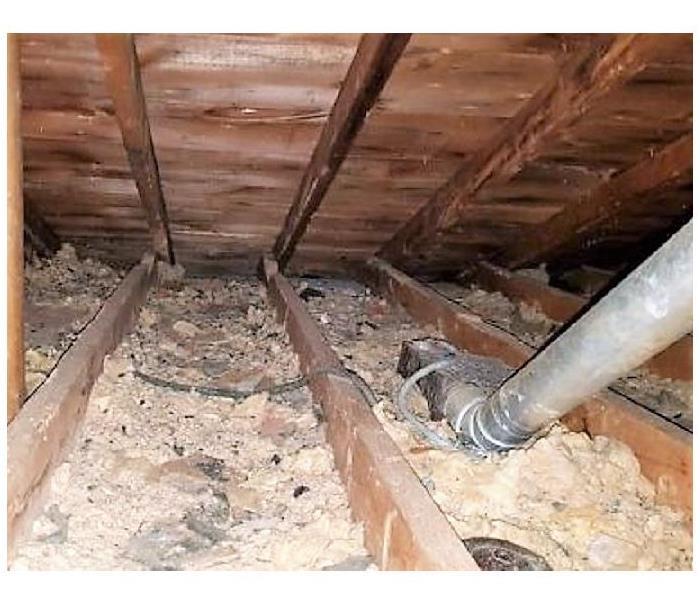 Blown in insulation can contain animal feces from bats, mice and other animals who are living in your attic.
Blown in insulation can contain animal feces from bats, mice and other animals who are living in your attic.
Many homes in the Southbury area have blown-in insulation. It’s a popular choice as it provides full coverage, is easy to install and is very efficient method of insulating the home. On occasion, a homeowner will find themselves in a situation in which the blown-in insulation will need to be removed from their home.
There are a number of reasons why the removal of blown-in insulation might be necessary including:
Water Damage Events:
When your home has a leak or flooding, the insulation will have water damage along with the rest of your home. Because wet insulation can promote mold growth, it can be a health hazard for those in the home. Wet insulation also loses its effectiveness because it has become compacted and no longer insulates your home as intended.
Old Insulation:
Today’s standards of insulation are far greater than what a home would have been required to have 20 years ago. Older insulation is thinner and has a lower R-value. If this is the case in your home, having it removed and replaced will help in keeping your home better insulated.
Animal Infestations:
Mice, bats, and birds often make a nice home of your attic space. The feces from these animals spread contaminants and disease in your home. Animal waste also causes the insulation to compact, creating a better environment for animals to build a nest, which will exacerbate the problem.
The SERVPRO of Southbury/Torrington team is experienced in blown in insulation removal.
We use commercial vacuums to safely and effectively remove the old insulation as well as any debris. Once the insulation has been removed, our team is able to assess any further damage to the structure, such as wet subfloors or walls, that will also require treatment or replacement. Once all of the damaged materials have been removed, the affected area is decontaminated and sanitized prior to the new insulation being blown in.
If you need the insulation in your home removed, call our office at (203) 267-6262 for an inspection today.
Leaking Roofs Causes Water and Mold Damage to Hartford County Homes
6/3/2019 (Permalink)
A leaking roof can cause not only damage the structural integrity of your Southbury home but can be a health and fire hazard as well. Leaks can be caused by a variety of reasons such as a roof that was incorrectly installed or damage from a storm or high winds. Here are some of the ways a roof leak can affect your home and family.
Compromised structure
A leaking roof can cause damaged rafters, ceiling joists and wall studs, as well as rotting to the interior and exterior trim. The water causes the wood to warp, weaken and deteriorate. Repairs to the infrastructure of your home can be costly.
Attic and ceiling damage
The initial dangers of a roof leak are damage to the attic area and the items stored there. If there is no attic, or the size of the leak is really big, it will damage the interior ceiling. You will notice water spots and perhaps bubbling or peeling on the affected ceiling and walls The dripping water can also damage ceiling fans and light fixtures.
Fire hazard from water damage
If electrical wiring is present in an attic or ceiling, a leaky roof could pose a fire threat from shorted wires. It is highly recommended to turn off electricity to the area that’s affected and have an electrician examine it.
Interior mold
One of the more serious issues that occur from a roof leak is mold growth. The consequences of letting the water settle without repairing the leak immediately can be harmful to your health. Mold damage can spread throughout the home’s structure, HVAC system and into personal belongings. Black mold is the most common type resulting from chronic water intrusion. SERVPRO of Southbury/Torrington can remediate mold found in your Harwinton home.
High utility bills/wasted energy
Water leaking through the roof causes damage to the insulation in the attic, which becomes saturated and takes a long time to dry out. If a roof leak repair is put off, your home will lose hot and cool air, resulting in higher utility bills.
If you discover that a roof leak has caused water or mold damage in your home, call us at (203) 267-6262.
Washing Machines, Dishwashers and Refrigerators and the Water Damage they can Cause
4/11/2019 (Permalink)
Sometimes, water damage comes from an unlikely source such as an appliance in your home.
In the past month, the team at SERVPRO of Newtown and Southern Litchfield County has responded to water damage emergencies in homes that were caused by leaking washing machines, dishwashers and refrigerator lines. The appliances failed without warning, leaving the homeowners dealing with an unexpected mess.
The problem with appliance leaks is that they often happen when the homeowner is away from the house. How many of us turn on the dishwasher prior to leaving our homes for the day? We expect to return to clean dishes but rather, find our homes flooded. Similarly, many of us run the washing machine while we are sleeping or not at home.In the case of a washing machine, failures can happen due to a leaky door seal, a loose hose or a shot pump.
It doesn’t take long for the water from an appliance leak to flood a house, leak through the floor and cause widespread damage. Appliance leaks cause damage to the wood flooring, carpets and the walls and ceiling of homes. The good news is that most insurance companies will cover water damage that is a result of a sudden malfunction of an appliance.
Nobody plans on an appliance leak in their home but they happen more often that you would imagine. We’ve seen this in the case of new and old appliances. Your immediate response when you discover an appliance leak at your home will be to stop the flow of water. Turning the water off at the main shut off valve (typically found in the basement of Newtown area homes) will stop any further flooding.
After the water has been shut off, call our office at (203) 743-5362. We are open 24-7 and the sooner the water damage restoration process begins, the easier the and quicker the work will be.
Older Homes in the Torrington Area are at Risk for Water Damage
4/9/2019 (Permalink)
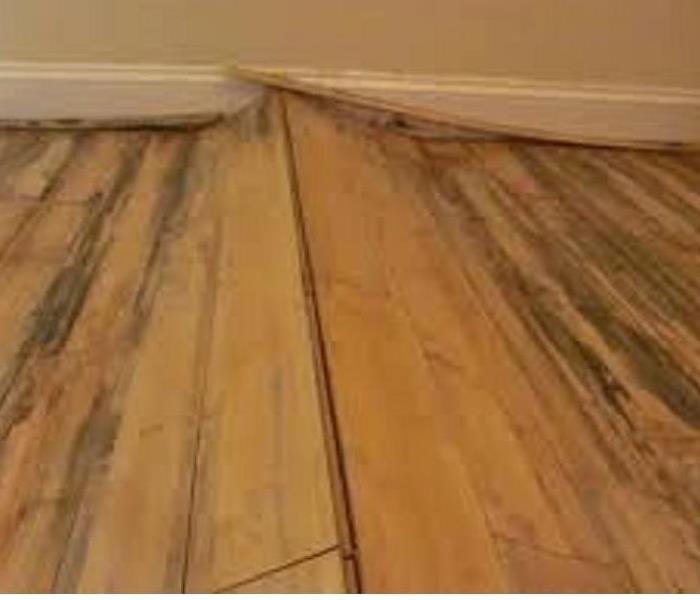 Wood floors buckling and with dark stains are a sure sign of water damage
Wood floors buckling and with dark stains are a sure sign of water damage
The Litchfield County area is known for its beautiful old houses in a picturesque setting. Hundreds of years old, these homes are reminders of how things used to be. We’ve seen homes in which the crawlspaces reveal rocks stacked on top of each other for the foundation. That these structures still stand is a testament to the craftsmanship of our ancestors.
As impressive as old houses are, however, it is inevitable that they might be plagued by structural problems. Foundations crack and shift, creating a risk of water damage. Old electrical wires that often do not meet code can fray as well as overload the system, causing an electrical fire. The plumbing systems that were added long after these homes were built are often not installed to today’s standards. Septic systems deteriorate and break with age. There are a host of problems that cause water damage to older homes.
If you have an older home in Connecticut, be vigilant about the warning signs of water damage.
Water stains. Water stains are the most common and obvious indication that you have a leak.You may see them on the ceilings or walls. Have all water stains inspected to see what the source is.
Deteriorating wood. In particular, keep your eye on door and window frames as well as baseboards and molding which are the first areas to show water damage because of a leaking window or door.
Buckling floors. If there is an appliance leak that goes unnoticed, a pipe leak under a sink or a gap around your shower door, you may end up with floors that absorb the water. Wood flooring absorbs the water, which makes it swell and buckle. Vinyl will curl up at the edges, which gives you a clue that there is a problem.
Pay attention to suspicious smells. If you notice a moldy or mildew smell, find the source even if there is nothing visible. Water damage can cause mold to grow behind walls and can cause serious damage if not mitigated.
Do you have water damage in your older home? Call Us Today (203) 267-6262.
CAT 1. CAT 2. CAT 3. Know the Different Types of Water Damage.
3/12/2019 (Permalink)
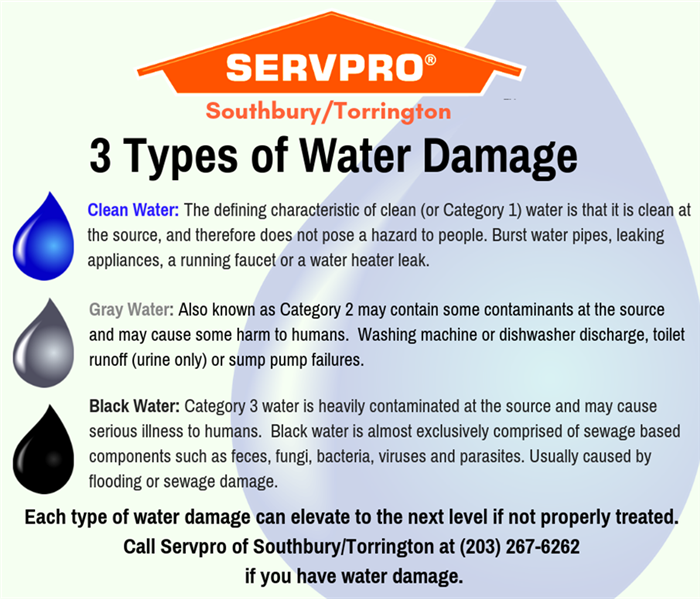 The cause of your water damage determines that type of restoration clean up that it requires.
The cause of your water damage determines that type of restoration clean up that it requires.
Our approach to treating water damage in Connecticut homes depends on which category it falls into.
CAT 1 or Clean Water
Clean water is just that- water that has come from a source that is not contaminated. Examples of this would be a pipe bursting or a refrigerator leak. Also, if you have a leak that allows rainwater in through your roof, it is considered clean. Although clean water can cause significant damage, it is not considered hazardous to human health as there are no microbes in the water. The biggest hazard clean water presents is if the area that has been damaged is not properly cleaned and dried. This can result in mold and fungus growth.
CAT 2 or Gray Water
Gray water is water that is slightly contaminated, either because of the nature of the source or because of neglect. For example, clean water can become “gray” water if it is left untreated for an extended period time. When a toilet or washing machine overflows, the resulting water would be considered gray because of its source. Toilet overflows containing urine only are considered gray.
CAT 3 or Black Water
CAT 3 water is highly dangerous to human health. Black water can include toxic materials such as bacterial diseases, chemicals, pesticides, microbes and more. Sewage based components such as bacteria, fungi, feces, viruses and parasites. Black 3 water situations are usually caused by sewage backups or overflows and flooding.
Since the human eye cannot see bacteria, it is not always obvious whether the water in your home is a CAT 2 or CAT 3. If you experience a flood from a heavy rain, the water may look “clean,” but if there is any ground water that has backed up into your home as a result, there may be invisible microbes lurking in the water.
Any water damage that is not treated correctly will eventually elevate to the next category. Even a simple pipe burst can turn into a biohazard and mold issue if not treated.
If you have any water damage in your home, call Southbury/Torrington at (203) 743-5362 for service that you can count on.
Scenes From Winter- Icicles can Cause Water Damage to Litchfield County Homes
2/14/2019 (Permalink)
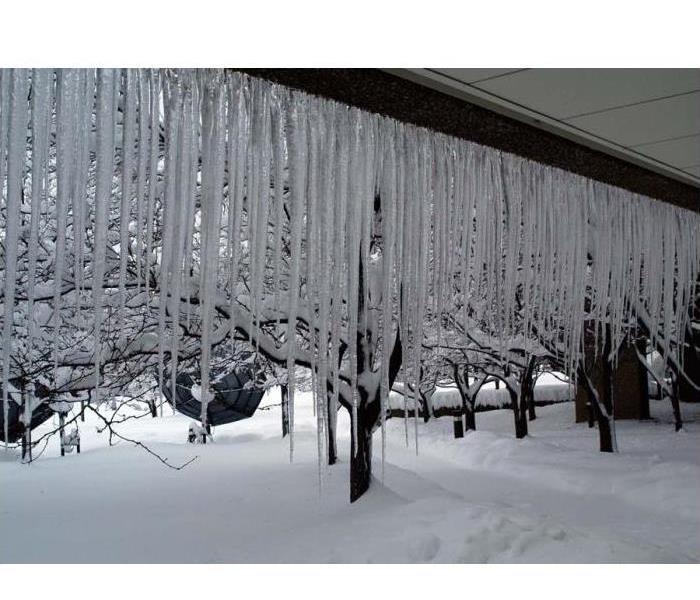 Icicles hanging off your roof can look pretty but also cause ice dams, which lead to water damage inside your home.
Icicles hanging off your roof can look pretty but also cause ice dams, which lead to water damage inside your home.
It can be postcard perfect - long shimmering icicles hanging from a snow covered roof of a beautiful Connecticut home.
But the reality is, snow and ice on your roof can be an indication that you might have an ice dam. Ice dams can cause damage to your roofing shingles as well as water damage to the interior of your home when they cause leaking through the roof.
Not all icicles indicate an ice dam. If icicles are simply hanging off of your gutters and don’t have a block of ice trapped behind them, they have most likely not compromised the integrity of your roof. However, icicles that are hanging directly from your roof may be preventing water from draining off of the roof. This causes the water to back up under the shingles and enter your home.
In addition to inspecting your roof for ice, we recommend taking a look in your attic and the exterior walls of your house for water stains. This may be an indication that an ice dam has formed and water has penetrated the roof membrane. Of course, a sure sign that you have a roof leak from an ice dam is water dripping through your ceiling!
Ice dam prevention is straightforward.
ROOF RAKE: A roof rake can be used to gently remove the snow on the edge of your roof, up to about 3-4 feet. Use caution not to damage your roofing shingles in doing so.
CALCIUM CHLORIDE: Use a calcium chloride ice melt product to melt the ice on your roof before it causes a problem. Be sure not to use rock salt or sodium chloride, which can damage your roof. Rather than just sprinkling the calcium chloride all over, we love this trick: Fill a nylon stocking with the calcium chloride and lay it across the ice dam. This creates a channel in the ice that deters roof damage.
Never allow water damage from an ice dam to go untreated.
If you don’t catch an ice dam prior to damage occurring, professional water damage mitigation is necessary. When water flows through insulation, sheetrock, and wood, it creates an environment where mold can grow hidden behind the walls.
For more information on the water damage restoration services offered by SERVPRO of Southbury/Torrington, please call us at (203) 267-6262.
Extreme Weather Causes Flooding in Torrington Area Homes and Businesses
1/28/2019 (Permalink)
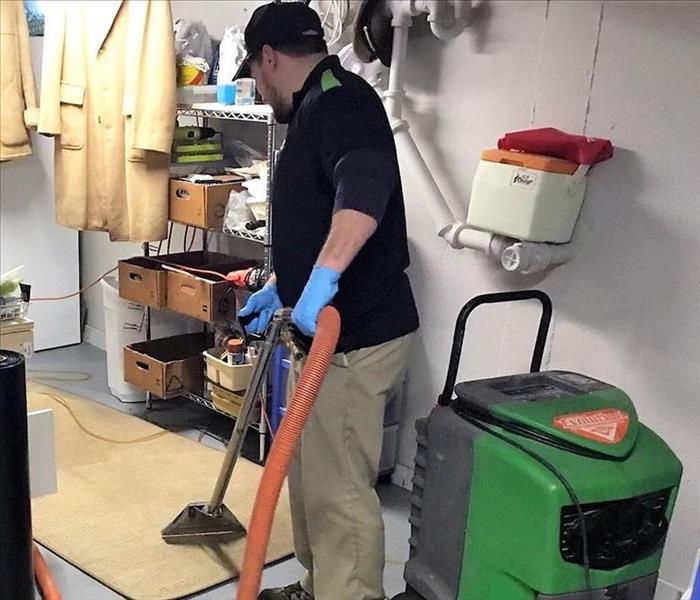 Last week's weather brought freezing temperatures followed by warm weather and heavy rain, leading to frozen pipes and flooded basements.
Last week's weather brought freezing temperatures followed by warm weather and heavy rain, leading to frozen pipes and flooded basements.
It's winter and we live in Litchfield County, CT so we expect to have harsh weather and last week we certainly got just that!
The week started with negative temperatures on Monday. This caused pipes to freeze in many buildings. In particular, areas of the home that are poorly insulated such as sunrooms, additions, garages and rooms with exterior walls that are hit by the wind were susceptible.
This cold front was followed by a dramatic rise in temperature (by almost 60 degrees!) and 3 inches of rain on Thursday. The warm weather allowed the ice in the frozen pipes to melt, and opened the way for hundreds of gallons of water to gush into Litchfield County homes.
The heavy rainfall was more than the still frozen ground could absorb and led to flooding of basements throughout the area as well.
When the weather causes the pipes to burst in your home and your basement to flood, give SERVPRO of Southbury/Torrington a call at (203) 267-6262. Our crew has the training, experience and resources to restore your home quickly and professionally.
Water Damage Restoration After Flooding in Vacant Harwinton Area Homes
12/28/2018 (Permalink)
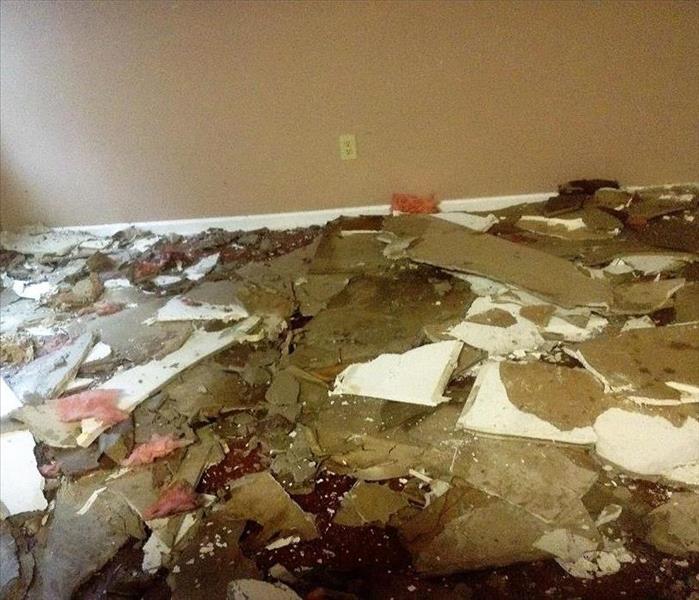 If your house is vacant because you vacation down South for the winter or are selling your home, be sure to take steps to protect it from water damage
If your house is vacant because you vacation down South for the winter or are selling your home, be sure to take steps to protect it from water damage
Vacant homes are among the most vulnerable structures to flooding.
Connecticut homes are often left unattended when a homeowner goes on vacation or travels south for the winter. We also receive water damage calls when a home is vacant because it is listed for sale or when the homeowner is deceased and the home is vacant while the estate is being settled.
During the winter, flooding often occurs due to burst pipes. This can occur for a number of reasons but in vacant homes the culprit is typically that the oil tank runs out. We've seen this happen even when a home is scheduled to be automatically refilled by the oil company. Errors occur and while typically this would be caught by the homeowner, when the house is vacant it goes unnoticed.
This results in a substantial amount of water flooding through the home with nobody there to notice it. We were once called by a homeowner who was away and notified of the water damage after their neighbors observed water pouring out from under the front door. Often when pipes burst in vacant homes, the damage is extreme- leaving collapsed ceilings and saturated walls. In addition to burst pipes, we've responded to homes in which water heaters have burst and appliances leaked.
Regardless of the source of the water, there are some precautions that homeowners can take to reduce their risk of damage.
If you are going on a vacation, leave a neighbor a key so that they can check on your home, especially if the temperature dips down into the single digits.
If you winter down South, consider having a family member or property management company care for your home so that missing oil deliveries or a broken oil burner doesn't go unnoticed.
Homes that are vacant can also be winterized - in which the water is drained from the pipes. The house will go unheated but there is no longer a risk of water damage from frozen pipes, broken appliances or a water heater burst.
Also, be vigilant about oil deliveries and ask your provider to notify you when a delivery occurs. Rather than simply leaving you a slip, request a phone call or email and keep track of the deliveries. This simple step can give you the peace of mind that your home will be dry and as you left it when you return home after the long winter.
Frozen Pipes Burst, Causing Water Damage in Litchfield County
12/14/2018 (Permalink)
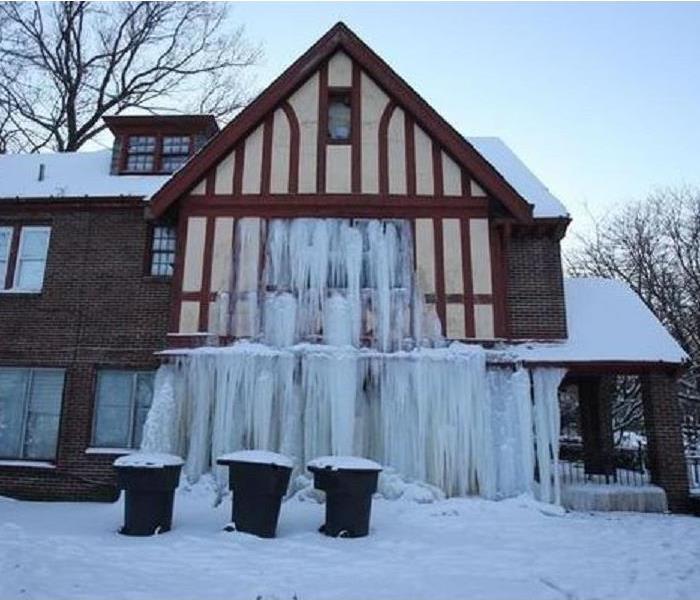 Don't let this happen to you! A few precautions can reduce your risk of frozen pipes.
Don't let this happen to you! A few precautions can reduce your risk of frozen pipes.
With the thermometer dipping into negative degrees this week, pipes in Litchfield County homes are at risk of freezing, especially because many homes are vacant while families travel for the holidays.
Although pipes can freeze anywhere in your home, there are some areas that are more susceptible than others.
1. Your Crawlspace - Many older homes in CT have a crawlspace rather than a full basement. These are typically not insulated and the pipes are exposed to the environment. Lining the sides of the space with foam board and the ground with plastic can help. You may also consider installing a heat cable that runs along the pipes and is turned on when the temps drop.
2. Under the Kitchen Sink - In particular, sinks that are on an exterior wall tend to experience frozen pipes. An easy solution to this is leaving your cabinet doors open to allow the warm air in the home to circulate.
3. Bonus Rooms Above the Garage - Most bonus rooms are built above an unheated garage. They are exposed to the cold air (especially along the exterior walls). Keeping the temperature in your garage above freezing with the use of space heaters on frigid days can help.
Frozen pipes can happen to anyone. We have responded to water damage from burst pipes in houses built in the 1700's as well as homes that are new construction. We've seen it all and have the experience to restore your home quickly and thoroughly.
Washing Machine Leaks Cause Water Damage to Torrington, CT Homes
12/11/2018 (Permalink)
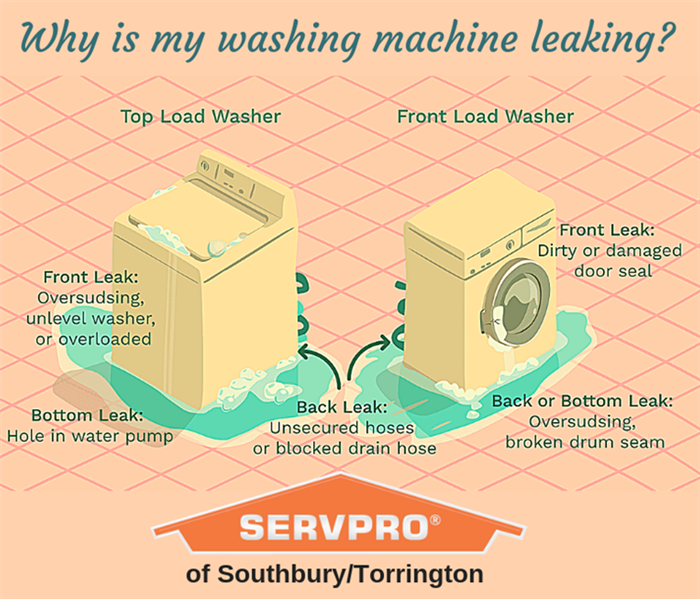 Washing machine leaks can be caused by a variety of reasons, causing water damage to Torrington area homes.
Washing machine leaks can be caused by a variety of reasons, causing water damage to Torrington area homes.
A leaking washing machine can cause substantial water damage to your Watertown, CT home. When a leak occurs, the water will flow out of your machine or it's hose until you discover the mess. The flooding can cause damage to wood floors, walls, furniture and even through the ceiling to the floors below. There are preventative steps homeowners can take to reduce their risk of an appliance leak.
- Make sure your hoses aren't kinked. There should be at least 4 inches between the wall and your washing machine.
- Check your detergent. Too much of it or the wrong kind (in high efficiency machines) can clog the overflow tube and cause a leak.
- Inspect to see that the drain hose is properly inserted into the drain line - it can become loose during machine use.
- Check your supply line hoses to make sure they aren't brittle or cracked. We recommend using stainless steel braided hoses to avoid deterioration.
- If your washing machine is in a high risk area (adjacent to living areas or on a second floor) consider installing a washing machine leak detector with an alarm that alerts you if it detects water on the floor. It will also close the valves so that flooding doesn’t continue.
- Turn off your washing machine water supply at the lever whenever you leave home for an extended period.
If you have flooding from a washing machine leak in your home, give SERVPRO of Southbury/Torrington a call at (203) 267-6262. Our team has over twenty years of experience in water damage restoration in Connecticut.
Leaking Roofs Cause FIre, Water and Mold Damage in Torrington, CT
11/16/2018 (Permalink)
A leaking roof can cause not only damage the structural integrity of your Torrington home but can be a health and fire hazard as well.
Leaks can be caused by a variety of reasons such as a roof that was incorrectly installed or damage from a storm or high winds.
Here are some of the ways a roof leak can affect your home and family.
Compromised structure
A leaking roof can cause damaged rafters, ceiling joists and wall studs, as well as rotting to the interior and exterior trim. The water causes the wood to warp, weaken and deteriorate. Repairs to the infrastructure of your home can be costly.
Attic and ceiling damage
The initial dangers of a roof leak are damage to the attic area and the items stored there. If there is no attic, or the size of the leak is really big, it will damage the interior ceiling. You will notice water spots and perhaps bubbling or peeling on the affected ceiling and walls The dripping water can also damage ceiling fans and light fixtures.
Fire hazard from water damage
If electrical wiring is present in an attic or ceiling, a leaky roof could pose a fire threat from shorted wires. It is highly recommended to turn off electricity to the area that’s affected and have an electrician examine it.
Interior mold
One of the more serious issues that occur from a roof leak is mold growth. The consequences of letting the water settle without repairing the leak immediately can be harmful to your health. Mold damage can spread throughout the home’s structure, HVAC system and into personal belongings. Black mold is the most common type resulting from chronic water intrusion. SERVPRO of Southbury/Torrington can remediate mold found in your Woodbury home.
High utility bills/wasted energy
Water leaking through the roof causes damage to the insulation in the attic, which becomes saturated and takes a long time to dry out. If a roof leak repair is put off, your home will lose hot and cool air, resulting in higher utility bills.
If you discover that a roof leak has caused water or mold damage in your Torrington, CT home, call SERVPRO of Southbury/Torrington at (203) 267-6262.
What to do if the Pipes Burst in Your Southbury Home or Business
11/8/2018 (Permalink)
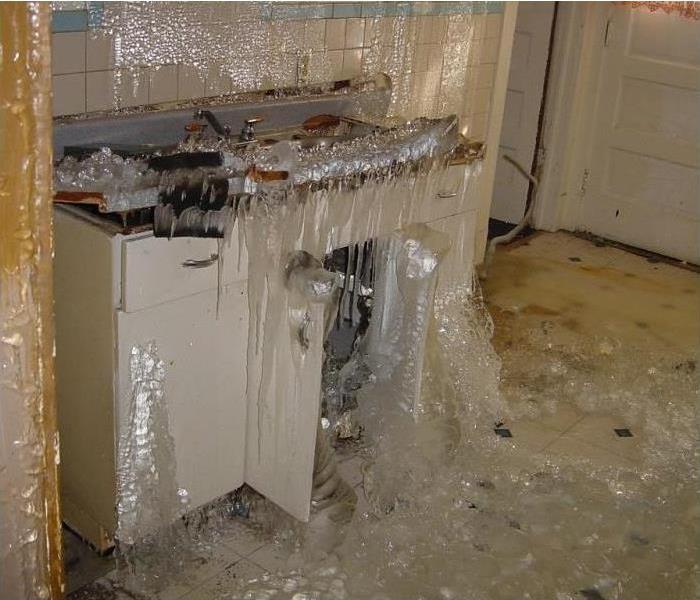 When pipes freeze and then burst, knowing which steps to take can save your home from extreme damage.
When pipes freeze and then burst, knowing which steps to take can save your home from extreme damage.
The most common call we get in the winter here in the Southbury, CT area is from customers whose pipes have frozen and burst. Often, a homeowner isn't aware that their pipes have frozen and they walk into their home after a thaw to a flood. As devastating as this might experience can be, there are steps that can be taken to minimize the damage while you wait for help to arrive.
Turn off your water and electricity.
If you live in a house, turn off your water supply (and don't wait until a pipe bursts to locate it!) as well as the electricity to the area of the house where the burst has occurred. If you live in an apartment building or condo, be sure to alert your building manager immediately as the water could also affect neighboring units.
Place a catch bucket under the leak
If water is coming through the ceiling, place a bucket or garbage can under the leak to catch the water. If the ceiling is bulging or the leaking is widespread, piercing a hole in the sheetrock will allow the water to flow through one spot.
Drain your pipes
Run all of the faucets throughout your house with cold water to clear as much water from the pipes as possible. Flush the toilets as well. Turn off your hot water heater and run the hot water from all faucets.
Call a plumber
Again, preparing ahead will work in your benefit. It can be difficult to find a plumber who is immediately available to respond to your frozen pipe emergency. Choosing and establishing a relationship with a local Litchfield County plumber ahead of time will go a long way in getting quicker service.
Call SERVPRO of Southbury/Torrington
Our water mitigation team will respond quickly and begin the clean up process. The sooner we are called to dry the home out and remove wet sheetrock, carpets, flooring and other materials, the less the damage can spread and cause additional problems.
Call your Insurance Agency
The sooner you submit a claim, the quicker you will be reimbursed for payments made to plumbers and contractors. Our experienced office staff, Theny, Alexis and Kathy, will handle insurance negotiations and paperwork from our end so that you don't have to.
Discovering that your home is flooded because of frozen pipes can be a stressful experience. We've been told by many customers throughout our twenty years as a franchise that having our team come out quickly and efficiently mitigate the damage has taken much of the stress out of the situation. Give us a call at (203) 267-6262 24/7 if your pipes freeze this winter in the Torrington area.
Water Damage Restoration of Flooded Basements in Southbury, CT
8/14/2018 (Permalink)
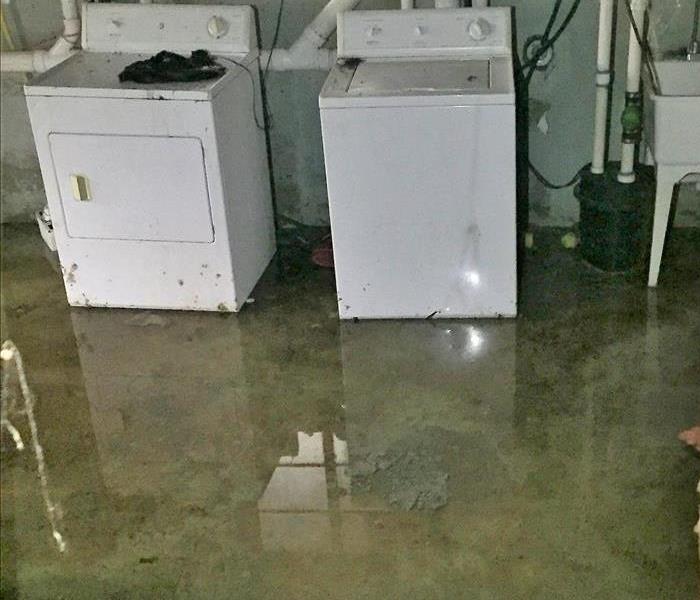 Basement floods can be caused by heavy rains, sewer backups, a broken pipe or a hot water heater tank failure.
Basement floods can be caused by heavy rains, sewer backups, a broken pipe or a hot water heater tank failure.
The area in a home or business that is most at risk of being flooded is the basement. A basement can flood at any time, although flooding most often occurs during heavy rainfall. Basements are inherently prone to flooding because they are the lowest level of a building and are normally built partly or entirely below ground level. There are a number of reasons why your Torrington, CT basement could flood, including:
- A blocked or failed sewer lateral pipe
- Heavy rain causes surface water to pool around your home
- Storm sewer backup
- Sanitary sewer backup
- Foundation drainage failure
- Water supply-line break or hot-water tank failure
There are some precautions that can be taken to reduce the likelihood of your basement flooding. Many Connecticut residents have a sump pump installed in their home to keep their basement dry. Grading the land around your foundation away from your home or building a drainage ditch are also effective measures. If you don't have a flood but your basement has high humidity that might lead to a mold problem, running a dehumidifier in your basement will help.
Have Questions about Basement Flooding?
Call Today - (203)267-6262.
If flood water is not handled quickly and properly, it can jeopardize your health and safety, and cause severe damage to your home’s structure. Remember, the longer you wait, the worse the problem will get.
The bottom line: a flooded basement can jeopardize your health, safety, and your home’s integrity. It’s worth making a call to SERVPRO of Southbury/Torrington and let our trained, professional crews handle the situation safely and correctly. We have earned the trust of hundreds of homeowners, business owners, and property professionals.
We are Flooded Basement Specialists:
- We are Available 24 hours/7 days per week
- We’re a Preferred Vendor to many National Insurance Companies
- We Bill The Insurance Directly – One Less Thing For You To Worry About
- Our Technicians are Highly-Trained in Water Restoration Techniques
- We use s500 IICRC Restoration Standards
- Advanced Inspection and Extraction Equipment
Basement Flooded?
Call Us Today (203)267-6262 – We’re Ready To Help
The Water Damage Restoration Process When You Call SERVPRO of Southbury/Torrington
5/23/2018 (Permalink)
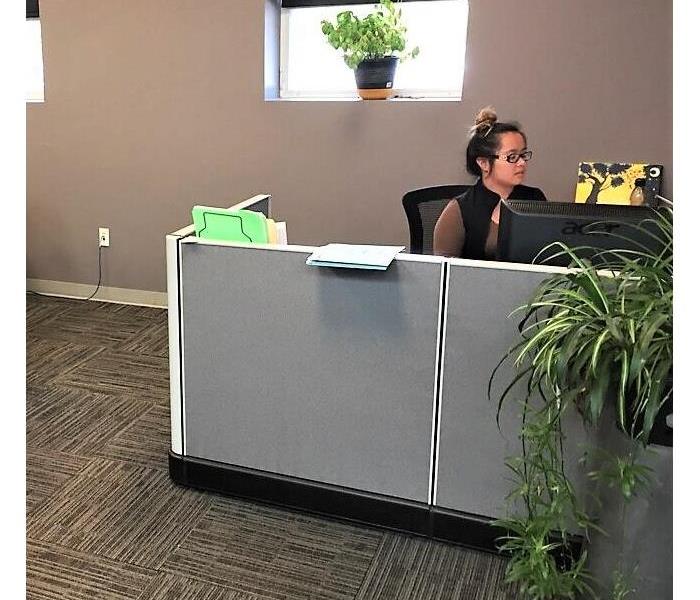 When you call us after having experienced water damage to your Torrington home, one of our administrative assistants will answer your call.
When you call us after having experienced water damage to your Torrington home, one of our administrative assistants will answer your call.
Quick action is crucial when you are dealing with water damage. The severity of the damage to your home can increase within just a few hours. This is the case no matter what has caused your water damage- whether it be from a broken refrigerator supply line, a leaking roof or a water heater burst.
When they pick up your call, Theny and Alexis, our Torrington office staff, understand that you may be feeling overwhelmed, stressed, and a bit vulnerable. Our staff has experience of taking hundreds of calls like yours each year and can calmly guide you through the process.
Upon answering your call, we will gather the necessary information in order to determine what equipment and resources will be needed as well as the size of the crew to send.
Some of the questions we might ask are:
- Your name and phone number as well as email address
- If you are a renter or property manager, the homeowner's contact information
- Your home insurance policy information
- The street address of the water-damaged home or business as well as the billing address
- When the water damage occurred and what caused it
- Whether there is electricity and heat available in the home
The following step will be for the office to schedule an appointment for one of our estimators to come to your home along with a crew to inspect the damages and formulate a restoration plan. The information that they have gotten from your call will help them determine how many technicians to send and what type of equipment is needed. Once we have inspected the damage, our crew will begin work.
We know that most of our clients have not experienced water damage before and may be unfamiliar with the terminology used and why certain actions need to be taken. Please know that if at any point you feel this way, our production managers and office staff are available to answer your questions.
The team at SERVPRO of Southbury/Torrington are your Connecticut water restoration specialists. If you have a flood or leak, call us at (203) 267-6262.
Restoring Household Contents After Water Damage in Your Watertown, CT Home
5/6/2018 (Permalink)
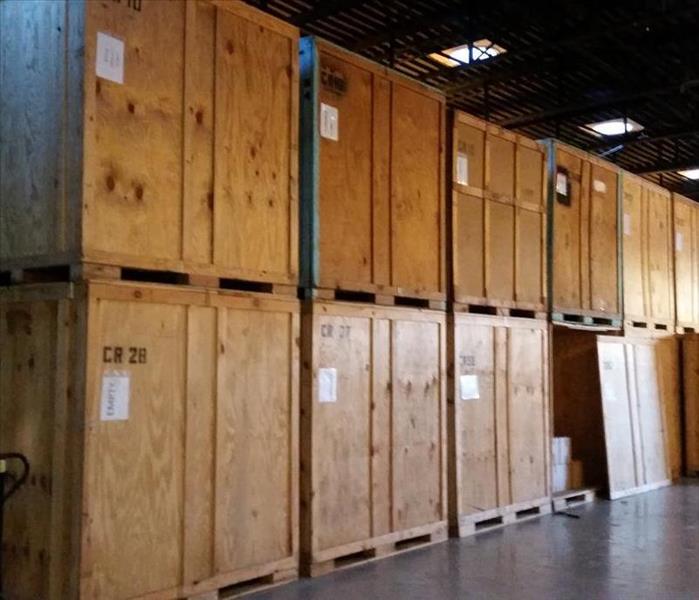 If your Southbury, CT home has extensive water damage, we may pack the contents of your home and store them safely at our facility during restoration.
If your Southbury, CT home has extensive water damage, we may pack the contents of your home and store them safely at our facility during restoration.
When a home has water damage from a flooded basement or a pipe burst, the contents of the home can be damaged as well as the structure.
The task of sorting through a families belongings to determine what should be restored and what should be replaced can be an emotional one. The SERVPRO of Southbury/Torrington crew understands how difficult this can be and is available to help our customers in this process.
When restoring a home after water damage, we typically order a dumpster to the home in which we place damaged materials such as wet sheetrock, insulation, wood floors and carpeting that cannot be saved. As we go through the contents, there will be some pieces of furniture that clearly cannot be saved. Typically, this would be porous items such as mattresses and furniture which is made out of particle board.
If we are uncertain whether we can save a particular item, we are able to pretest them to determine whether they can be brought back to their original condition. We utilize several methods of cleaning your contents, including the following:
- Dry Cleaning - Used for cleaning light residues or to pre-clean prior to wet cleaning.
- Wet Cleaning - An effective cleaning method for removing moderate to heavy residues.
- Spray and Wipe -Effective for items that can’t withstand wet cleaning.
- Foam Cleaning - Used for upholstery fabrics that might shrink or bleed if wet cleaned.
- Abrasive Cleaning - Involves agitation of the surface being cleaned.
- Immersion Cleaning - Contents are dipped into a bath of the cleaning product.
Our franchise offers a Contents Claim Inventory Service to our customers, which provides them a list of their belongings and their values. This helps our customers provide the needed documentation to their homeowner's insurance company to be reimbursed for damages.
As we walk through a home, a customer may identify certain items of sentimental value. We will make our best effort to restore these treasured items such as a favorite stuffed animal, a photo album or an important document. We have five options for the restoration of documents, which is dependent on the level of damage to the documents.
- Air Drying
- Dehumidification
- Freezer Drying
- Vacuum Freeze Drying
- Vacuum Thermal Drying
Homes that have extensive damage may require the furnishings be removed during restoration. SERVPRO of Southbury/Torrington offers full content moving service. This includes the packing up of your belongings, transportation to our storage facility and the return of your items when restoration is complete. Not only does our pack out services help us restore your home quicker and with more ease, it also protects your belongings from further damage from moisture in the air, which can cause mold spores to grow.
The SERVPRO of Southbury/Torrington team understands that it can be difficult to part with sentimental belongings and we are diligent in our effort to restore them if possible. From our initial walk through, to the return of your belongings when the restoration is complete, our goal is to be respectful and helpful to families who are going through a difficult ordeal.
Tips to Keep the Spring Thaw From Flooding Your Harwinton Home
4/10/2018 (Permalink)
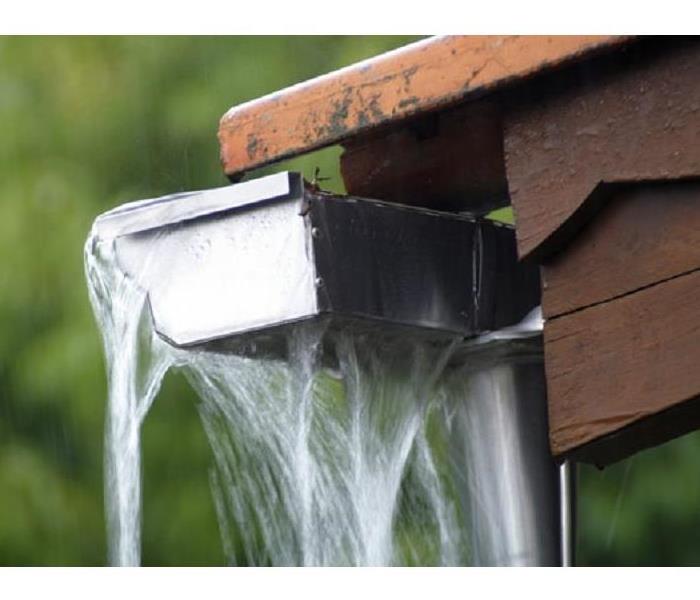 Clogged gutters will flow over the side, causing water to collect at your houses foundation. This can lead to flooding in your basement.
Clogged gutters will flow over the side, causing water to collect at your houses foundation. This can lead to flooding in your basement.
Although we've still seen some snowflakes coming down in the past week, I think (hope) it's safe to say that winter is finally coming to an end. With warmer temperatures coming this week, the ground is thawing out and with that, excess water will be created. Unless you have a water proof house, this could cause flood problems, particularly in your basement. We've compiled a few flood prevention tips that will help protect your home this spring. If you already have water damage at your home, contact SERVPRO of Southbury/Torrington at (203) 267-6262 for immediate water damage restoration help.
- Inspect the drainage system: The drainage system on your property must be free of obstructions so the melted snow and ice will drain away from your home. Open your roof drains and make sure the floor drains of free of debris. If you have flood drains outside your home, make sure they are clear as well.
- Inspect your gutters and downspouts: It's important to make sure that your downspouts and gutters are clear so that any ice and snow that is melting off of your roof has an exit point. With the winter we had, which brought high winds and snowstorms, there can be a plethora of leaves, twigs and branches blocking your gutters. This can cause water damage by allowing water to enter your home through the roof. Also, if the water cannot drain properly, it will flow over the side of your gutter instead. This causes water buildup near the foundation of your home., which can lead to flooding in your basement.
- Test your sump pump: Many houses in Connecticut have sump pumps to assist in keeping the basement dry. Sump pumps are a fantastic idea but only if they are working! Our Torrington office receives several calls a year from homes in which there is water damage from sump pump failure. There are some simple steps that you can take to make sure that your sump pump is in proper working order. We recommend doing so in early spring.
It's been a long winter and we are finally coming out of it. Don't let your enjoyment of spring be hindered by a flooded basement or leaky roof. Following our tips takes just a few hours and will help prevent any melting snow and ice from entering your home. If you have water damage from flooding this spring, call the SERVPRO of Southbury/Torrington team for professional water damage restoration with experience and training you can count on.
Tips To Help Prevent Pipes From Freezing:
1/4/2018 (Permalink)
Winter is in full effect! In an effort to help keep your pipes from freezing, consider the following tips:
Outdoor Care:
Disconnect all garden hoses and if there is water shut off valve, turn it off! Also, consider installing covers on exterior water supplies.
Prevent the water meter from freezing during cold weather by keeping it securely covered.
Indoor Care:
Identify the location of the main and water heater shut-off(s). Knowing the location of these valves can come in handy during an emergency and could help prevent further damages.
Be sure that your home’s thermostat is NOT below 60 degrees.
Leave cabinet doors below sinks open to allow heat from home to circulate.
Close all windows and seal any gaps open to the outside elements, especially those near water pipes. Freezing temperatures combined with wind drafts can cause pipes to freeze.
Insulate pipes that are near exterior walls or in unheated spaces of your home. This can prevent freezing, especially for interior pipes that may run along outside walls.
Seal leaks that allow cold air into your home by weather strip, caulking or insulating. Check air leaks around flue or chimney chase, electrical wiring, dryer vents and pipes. Also, consider insulating outside walls that are in unheated spaces of a home.
If away, shut off water supply valves to your washing machine.
Leave lukewarm water dripping slowly from faucets during extremely cold periods. Water moving through the system should prevent lines from freezing.
If a Pipe Bursts:
Shut off water at the main valve.
If the break is in a hot water pipe, the valve on top of water heater should also be turned off.
Call a plumber immediately! Then call SERVPRO of Southbury/Torrington to make it, “Like it never even happened.”
With Colder Temperatures, Are Your Pipes at Risk?
1/4/2018 (Permalink)
As temperatures continue to drop, pipes are at risk of freezing, especially while families are traveling for the holidays.
Although pipes can freeze anywhere in your home, there are some areas that are more susceptible than others:
- Crawlspace- Many older homes in CT have a crawlspace rather than a full basement. They are typically not insulated and the pipes are exposed to the environment. Lining the sides of the space with foam board and the ground with plastic can help. You may also consider installing a heat cable that runs along the pipes and is turned on when the temperature drops.
- Under the Kitchen Sink- In particular, sinks that are on an exterior wall tend to experience frozen pipes. An easy solution to this is leaving your cabinet doors open to allow the warm air in the home to circulate.
- Bonus Rooms Above the Garage- Most bonus rooms are built above an unheated garage. They are exposed to the cold air (especially along the exterior walls). Keeping the temperature in your garage above freezing with the use of forced air heater unit for those frigid days can help.
When the unexpected happens, we can help restore your home quickly and thoroughly, call us at 203-267-6262.
Clean Your Gutters!
11/29/2017 (Permalink)
To help minimize potential exterior/interior, water issues be sure to clean your gutters and drains to ensure that water is properly draining from your home or building.
Our office is commonly flooded with phone calls during the fall due to backed up gutters and drains that enter a home or business and cause water damage. The backing up of gutters is very common due to the simple fact that leaves, acorns, and other debris build up in the gutters and rain water has no where to go but into your home.
This same type of debris indicated above can cover up drains along foundations and patios which will lead to water damage to basements and lower levels of your home. Not only can water damage occur to your interior living space, but the even more costly damage can take place such as foundation damage, peeling paint, rot to sill plates, and other costly items.
Simply put an ounce of prevention will lead to pounds of protection by just maintaining the water drainage system designed to protect your house or building.
If water damage does occur to your home it is imperative to address it immediately. We are available to help 24/7 at SERVPROsouthburytorrington.com
Signs That Your Hot Water Tank Could Be Failing You
11/29/2017 (Permalink)
Signs That Your Hot Water Tank Could Be Failing You!
The average hot water heater lasts approximately 10 years before it needs to be replaced. Internal parts of the heater can corrode or over time and develop mineral buildup. Mineral buildup can compromise the efficiency of the heater. Regular flushing and professional annual maintenance can help prolong the life span of the unit. To avoid any disruption or damage of a failing water heater. Below are indicators that your water heater may be in need of repair and/or replacement.
Common signs to look for:
- Insufficient water
- Noisy water heater
- Cloudy or hot water that may have an odor
- Metallic water taste
- Rust or leaks around connections
- Leaking tank
If you are experiencing any of the above signs, have it serviced immediately by a plumber immediately! For more information we invite you to visit our site at www.SERVPROsouthburytorrington.com.
High Humidity Effects
11/2/2017 (Permalink)
During a water damage to your home or business while some of your contents might not have been directly affected by the water, however the moisture in the air could have devastating and long lasting effects.
Clothing items, soft fabrics, and upholstered items exposed to high humidity are more likely to be ruined by mold and secondary damages. Besides microbial growth that can occur, high humidity from water damage can deflect, bend, or reshape these soft good items. High humidity will not distinguish between designer suits or an old pair of sweatpants, so realizing the problem and resolving it quickly is the best prevention to protect your content items.
Furniture covered with fabric has a lot of area for potential mold growth. When mold forms on upholstered furniture exposed to high humidity, repair can be very difficult or impossible. And who wants a smelly sofa?
While all of the conditions described above sound upsetting, they’re easily avoided. With Proper Water Mitigation and Drying. Here are SERVPRO of Southbury/Torrington we are trained in how to respond when this type of damage occurs. Please check out our website for additional info about water damage and high humidity secondary damages. http://www.SERVPROsouthburytorrington.com/
Ground Water Flooding Due to Recent Storms
11/2/2017 (Permalink)
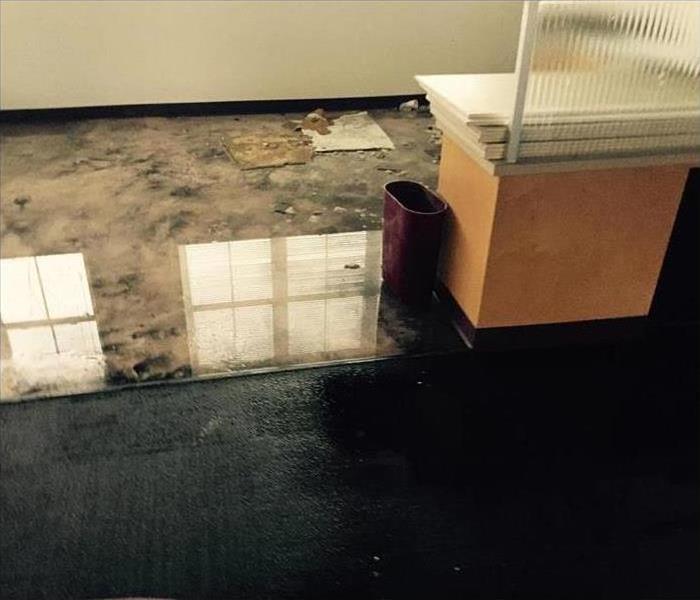 an example of ground water coming up through the floor.
an example of ground water coming up through the floor.
The fast moving rain and thunder storms that are running across CT on 10/24/17 from west to east are causing flash flooding to many homes and businesses in a widespread fashion. It is crucial for homeowners and business owners to deal with ground water entering their properties in an immediate fashion.
Groundwater can carry unknown contaminants that can travel with the rain water that passes through the soil and pickup potential pesticides and other unknown contaminants and deposit them in your affected areas. For example, Beryllium, naturally occurs in soil and groundwater. To learn more about the effects of Beryllium from water damage, please follow this link for more information https://water.usgs.gov/edu/groundwater-contaminants.html
If you happen to experience water damage to your home or business, we are available to assist in the proper removal and water restoration 24/7 and 365 days a year to your property. For additional tips and info and contact information please click on our website at http://www.SERVPROsouthburytorrington.com/
SERVPRO of Southbury/Torrington is an IICRC certified firm that specializes in water damage restoration.




 24/7 Emergency Service
24/7 Emergency Service